Avnet AVTEG001 WLAN and BT LE Module User Manual Data sheet
Avnet Inc WLAN and BT LE Module Data sheet
Avnet >
Data sheet
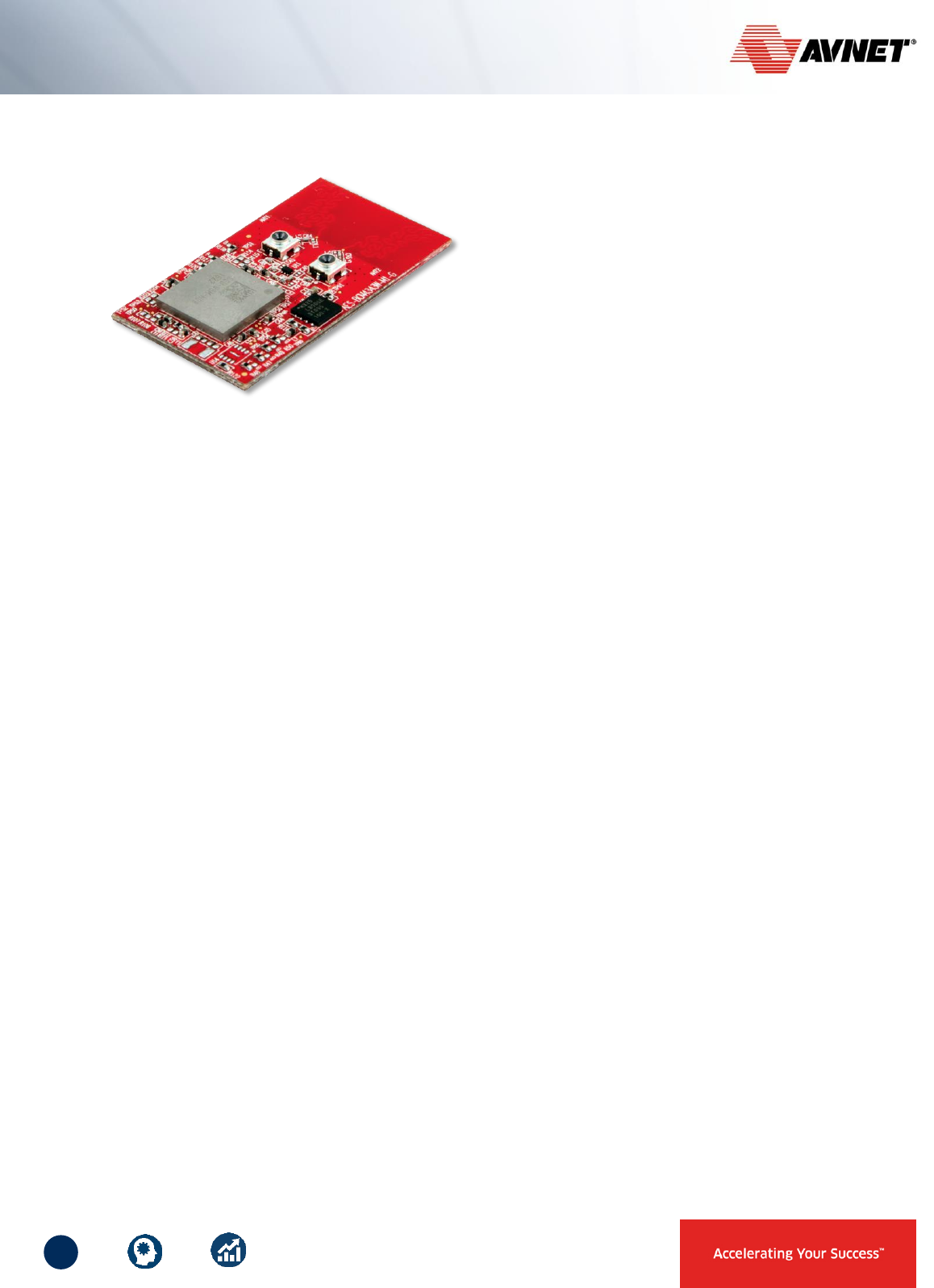
1
1
AES-BCM4343W-M1-G Datasheet
802.11 b/g/n WLAN, Bluetooth & BLE SoC Module
December 2016 Version 2.2
Description
Features
The Avnet AES-BCM4343W-M1-G module is
a high performance, Wi-Fi and Bluetooth/BLE
combo module that includes a programmable
ARM® Cortex™ M4 microprocessor for
running user application code. The module is
ideal for low-power Internet of Things (IoT)
enabled sensor and actuator based devices
that need wireless connectivity to cloud
services. The compact 35 x 20mm LGA
package makes the module a perfect fit for
small, embedded applications.
This Avnet SoC Module is pre-certified, thus
minimizing development time and
certification costs. The module combines an
advanced Cypress® 2.4GHz 802.11 b/g/n
and Bluetooth® 4.1 SoC with 8Mb of serial
Flash and a ST Microelectronics STM32F411
ARM® Cortex™ M4 MCU supporting 512KB
Flash and 128KB SRAM. Several of the M4
MCU peripheral functions are made available
on the module I/O, allowing for easy
connection to user specified interfaces.
Advanced security capabilities are available
with an optional authentication chip.
Dual onboard fractal PCB antennas provide
antenna diversity for optimized RF
performance.
• Based on integrated SIP device that includes:
o Combo Wi-Fi & BT/BLE SoC (BCM4343W)
o Host Application Processor (STM32F411)
• BCM4343W WLAN radio:
o 2.4 GHz IEEE 802.11b/g/n(20),
Channels 1-11 for USA and Canada
• BCM4343W Bluetooth radio:
o Bluetooth® v4.1 (LE and Classic modes)
• STM32F411 ARM® Cortex™ M4 microcontroller
features include:
o 512KB Flash and 128KB SRAM
o Multiple peripheral interfaces:
Digital I/O – 6
Analog inputs – 4
I2C Ports – 2
SPI Port – 1
UART Ports - 2
o JTAG programing and debug port
• 8Mb SPI serial flash for storage of firmware
upgrades and user accessible R/W file system
• Antenna Diversity implemented using onboard
dual fractal PCB antennas
• Concurrent WLAN and Bluetooth operation
(coexistence algorithm for shared antennas)
• Comprehensive software development tools:
o Cypress WICED™ SDK
o ZentriOS SDK
• Compact 35 x 20 mm 45-pin LGA package
• Operating temperature: -40° to +85° C
• FCC, IC and CE certifications: currently pending
• BT SIG QDID: coming soon
Applications
• Industrial Automation
• Security & Building Automation
• Smart Home Appliances
• IoT and M2M Connectivity
• Wi-Fi/BLE Gateway

2
2
AES-BCM4343W-M1-G Datasheet
802.11 b/g/n WLAN, Bluetooth & BLE SoC Module
Document Control
Document Version:
Version 2.2
Document Date:
23 December 2016
Document Author(s):
JB, PF
Document Classification:
Released
Document Distribution:
Public
Prior Version History:
Version:
Date:
Comment:
0.1
5/2/16
Initial release
0.2
5/2/16
Updated Module Features
0.3
5/2/16
Added SPI flash and Antenna details
1.0
6/27/16
Tape & Reel Packaging and Antenna
Options sections updated
2.0
11/16/16
Specs for low-power modes added
References to Broadcom removed
Reference to BT/BLE 4.2 removed
Option of using external antennas removed
2.1
12/19/16
Miscellaneous updates. Wi-Fi and BT
versions and channel detail noted
2.2
12/23/16
256-QAM (TurboQAM) mode removed
Data rate max reduced to 65 Mbps
Regional contact info updated
Comments:

3
3
AES-BCM4343W-M1-G Datasheet
802.11 b/g/n WLAN, Bluetooth & BLE SoC Module
1 Table of Contents
2 Table of Figures .................................................................................................... 5
3 Functional Overview.............................................................................................. 6
3.1 Microcontroller .......................................................................................................... 6
3.2 SPI Flash Memory .................................................................................................... 6
3.3 WLAN ...................................................................................................................... 7
3.4 Bluetooth .................................................................................................................. 7
3.5 Antennas .................................................................................................................. 7
4 Block Diagram ....................................................................................................... 8
5 Module Pin Descriptions ....................................................................................... 9
5.1 Pin Descriptions ....................................................................................................... 9
5.2 Pin Definitions ........................................................................................................ 10
6 Electrical Specifications ...................................................................................... 11
6.1 Absolute Maximum Ratings .................................................................................... 11
6.2 Recommended Operating Conditions ..................................................................... 11
6.3 Power Supply Requirements .................................................................................. 11
6.4 WLAN Power Consumption .................................................................................... 12
6.5 Bluetooth Power Consumption ............................................................................... 12
6.6 Bluetooth Low Energy Power Consumption ........................................................... 12
6.7 Low Power Modes Power Consumption ................................................................. 12
7 RF Specifications ................................................................................................ 13
7.1 WLAN RF Characteristics....................................................................................... 13
7.1.1 Transmitter Specification ....................................................................................................14
7.1.2 Receiver Specification ........................................................................................................15
7.2 Bluetooth RF Characteristics .................................................................................. 17
7.2.1 Transmitter Specification ....................................................................................................17
7.2.2 Receiver Specification ........................................................................................................17
7.3 BLE RF Characteristics .......................................................................................... 18
8 Mechanical Specifications ................................................................................... 19
8.1 Mechanical Size ..................................................................................................... 19
8.2 Module PCB Footprint ............................................................................................ 20
8.3 Module Pad Size .................................................................................................... 20
8.4 Recommended Solder Paste Mask ........................................................................ 21
8.5 Recommended Solder Mask .................................................................................. 21
8.6 Tape and Reel Packaging ...................................................................................... 22
9 Soldering and Cleaning Recommendations ........................................................ 23
9.1 Optimum Soldering Reflow Profile .......................................................................... 23

4
4
AES-BCM4343W-M1-G Datasheet
802.11 b/g/n WLAN, Bluetooth & BLE SoC Module
9.2 Cleaning ................................................................................................................. 23
10 Antennas ............................................................................................................. 24
11 Certifications ....................................................................................................... 25
11.1 RoHS ..................................................................................................................... 25
11.2 Regulatory Compliance .......................................................................................... 25
11.3 Bluetooth Interoperability Compliance .................................................................... 25
11.4 Regulatory Agency Statements .............................................................................. 25
11.5 OEM Instructions .................................................................................................... 26
11.6 OEM Labeling Requirements ................................................................................. 26
11.7 Limitations .............................................................................................................. 26
12 Shipping, Handling and Storage ......................................................................... 27
12.1 Shipping ................................................................................................................. 27
12.2 Handling ................................................................................................................. 27
12.3 Moisture Sensitivity (MSL) ...................................................................................... 27
12.4 Storage .................................................................................................................. 27
13 Ordering Information ........................................................................................... 28
13.1 Module Accessories ............................................................................................... 28
14 Contact Information ............................................................................................. 29

5
5
AES-BCM4343W-M1-G Datasheet
802.11 b/g/n WLAN, Bluetooth & BLE SoC Module
2 Table of Figures
Figure 1 – AES-BCM4343W-M1-G Module Block Diagram .................................................................... 8
Figure 2 – AES-BCM4343W-M1-G Module Top View .......................................................................... 19
Figure 3 – AES-BCM4343W-M1-G Module Side View ......................................................................... 19
Figure 4 – AES-BCM4343W-M1-G Module PCB Footprint ................................................................... 20
Figure 5 – AES-BCM4343W-M1-G Module Pad Size ........................................................................... 20
Figure 6 – Recommended Solder Paste Mask Size ............................................................................. 21
Figure 7 – Recommended Solder Mask Size ........................................................................................ 21
Figure 8 – Tape Dimensions ................................................................................................................. 22
Figure 9 – Recommended Soldering Profile for Lead-Free Solder ....................................................... 23
Figure 10 – Dual Fractal PCB Antennas ............................................................................................... 24
Figure 11 – Test Probe Connectors (Murata SWD series) ................................................................... 24

6
6
AES-BCM4343W-M1-G Datasheet
802.11 b/g/n WLAN, Bluetooth & BLE SoC Module
3 Functional Overview
This 2.4GHz wireless module provides a complete combo Wi-Fi/BT/BLE and MCU solution for cost-
effective embedded-wireless IoT applications. Based on latest-generation Cypress BCM4343W
Wireless SoC silicon, this high performance combo module provides a unique solution with Wi-Fi and
Bluetooth radios, ARM Cortex-M4 host processor and expansion SPI Flash memory, plus versatile
dual onboard and dual external antenna capabilities, all in a compact 35 mm x 20 mm, easy to mount
(0.1” pitch LGA) form-factor module, qualified for operation across the full industrial temperature range
3.1 Microcontroller
The AES-BCM4343W-M1-G module includes an on-board microcontroller (MCU) that interfaces with
the Cypress BCM4343W radio for communication and acts as the system controller for user
applications. Based on the ST Microelectronics STM32F411, the MCU supports the following features:
STM32F411 ARM 32-bit Cortex™-M4 (with FPU), @ 100 MHz
On-chip memory: 512 kbytes Flash, 128 Kbytes SRAM
Multiple serial communication interfaces: SPI, USART, PCM
Sensor applications support: ADC, I2C, I2S, GPIO, Timers
Cypress WICED SDK and ZentriOS SDK based cloud connected application examples are
provided (AWS IoT, IBM Bluemix, ThingSpeak and others…)
Debug support: JTAG interface
Application code for the module can be developed using Cypress’s WICED Software Development Kit
(SDK) or Zentri’s ZentriOS SDK.
Additional details on the STM32F411 MCU features, specifications, and programming modes can be
obtained from the STM32F411 datasheet.
3.2 SPI Flash Memory
An 8 Mbit SPI Flash memory (Macronix MX25L800EZUI12G) is included on the module for the storage
of BCM4343W firmware, static webpages, built-in documentation, images, etc. The STM32F411
MCU’s SPI1 peripheral interface, clocked at 50MHz, is used to communicate with this memory.
The SPI1 interface parameters are defined in the BCM94343W_AVN platform files of the Cypress
WICED SDK development environment. When building an application in WICED SDK, adding the
download_apps parameter to the make target command string, ensures that the BCM4343W
firmware is written to- and loaded from this SPI flash
MCU
WICED SDK
SPI1 Signal Name
Pin Name
Pin Name
SPI_FLASH_CS
PA4
WICED_GPIO_5
SPI_FLASH_CLK
PA5
WICED_GPIO_6
SPI_FLASH_MISO
PA6
WICED_GPIO_7
SPI_FLASH_MOSI
PA7
WICED_GPIO_8

7
7
AES-BCM4343W-M1-G Datasheet
802.11 b/g/n WLAN, Bluetooth & BLE SoC Module
3.3 WLAN
Cypress BCM4343W combo single-chip MAC, Baseband and RF device
(includes ARM Cortex-M3 processor)
Frequency Band: Single-band, 2.4 GHz only
WLAN Network Standards supported: 802.11b, 802.11g, 802.11n (single stream)
Modulation Modes: CCK and OFDM with BPSK, QPSK, 16QAM, 64QAM
Supported Data Rates:
- IEEE 802.11b 1 – 11 Mbps
- IEEE 802.11g 6 – 54 Mbps
- IEEE 802.11n 7.2 – 65 Mbps (2.4 GHz only)
Hardware Encryption
- WEP, WPA / WPA2 Personal
Advanced 1x1 802.11n Features:
- Full/Half Guard Interval
- Frame Aggregation
- Space Time Block Coding (STBC)
- Low Density Parity Check (LDPC) Encoding
SDIO host interface for WLAN subsystem (between BCM4343W and STM32F411 MCU)
Optional WLAN Debug Interfaces:
- WLAN JTAG and WLAN Debug UART interfaces are pinned-out to support special cases
(most application development will not require this)
3.4 Bluetooth
Bluetooth 4.1 (supporting Bluetooth Low Energy) with backward compatibility
Bluetooth Smart Ready (support for Dual-mode Bluetooth Classic and BLE operation)
Advanced Algorithm for support of Bluetooth/BLE and Wi-Fi coexistence
(for concurrent WLAN and Bluetooth operation)
Dedicated high-speed UART for Bluetooth host interface
3.5 Antennas
Onboard dual fractal PCB antennas (Cypress patented PCB trace antennas)
Miniature switched RF connectors. These are for test purposes only!
Transmit and Receive antenna diversity
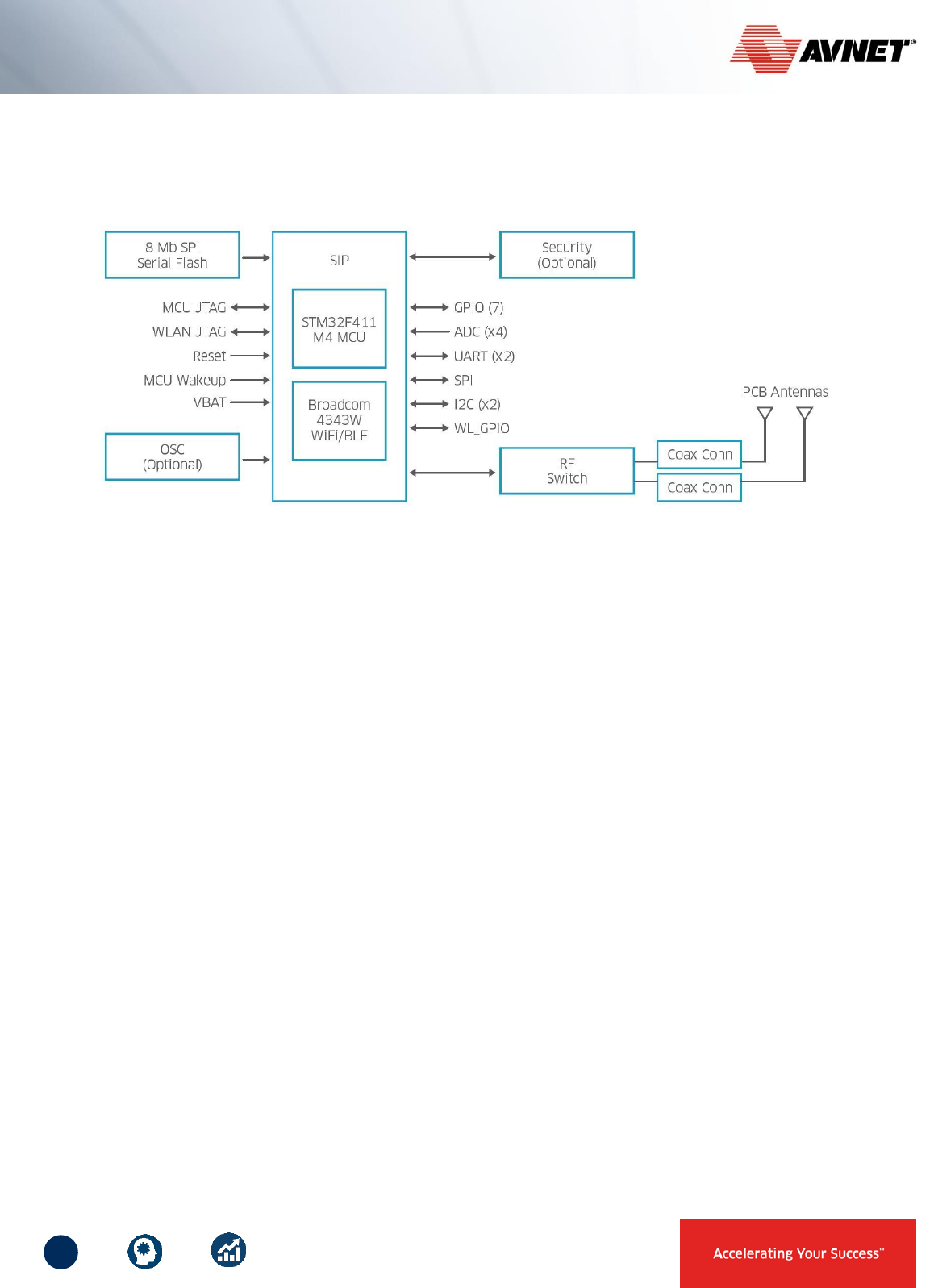
8
8
AES-BCM4343W-M1-G Datasheet
802.11 b/g/n WLAN, Bluetooth & BLE SoC Module
4 Block Diagram
Figure 1 shows a functional block diagram of the AES-BCM4343W-M1-G module.
Figure 1 – AES-BCM4343W-M1-G Module Block Diagram
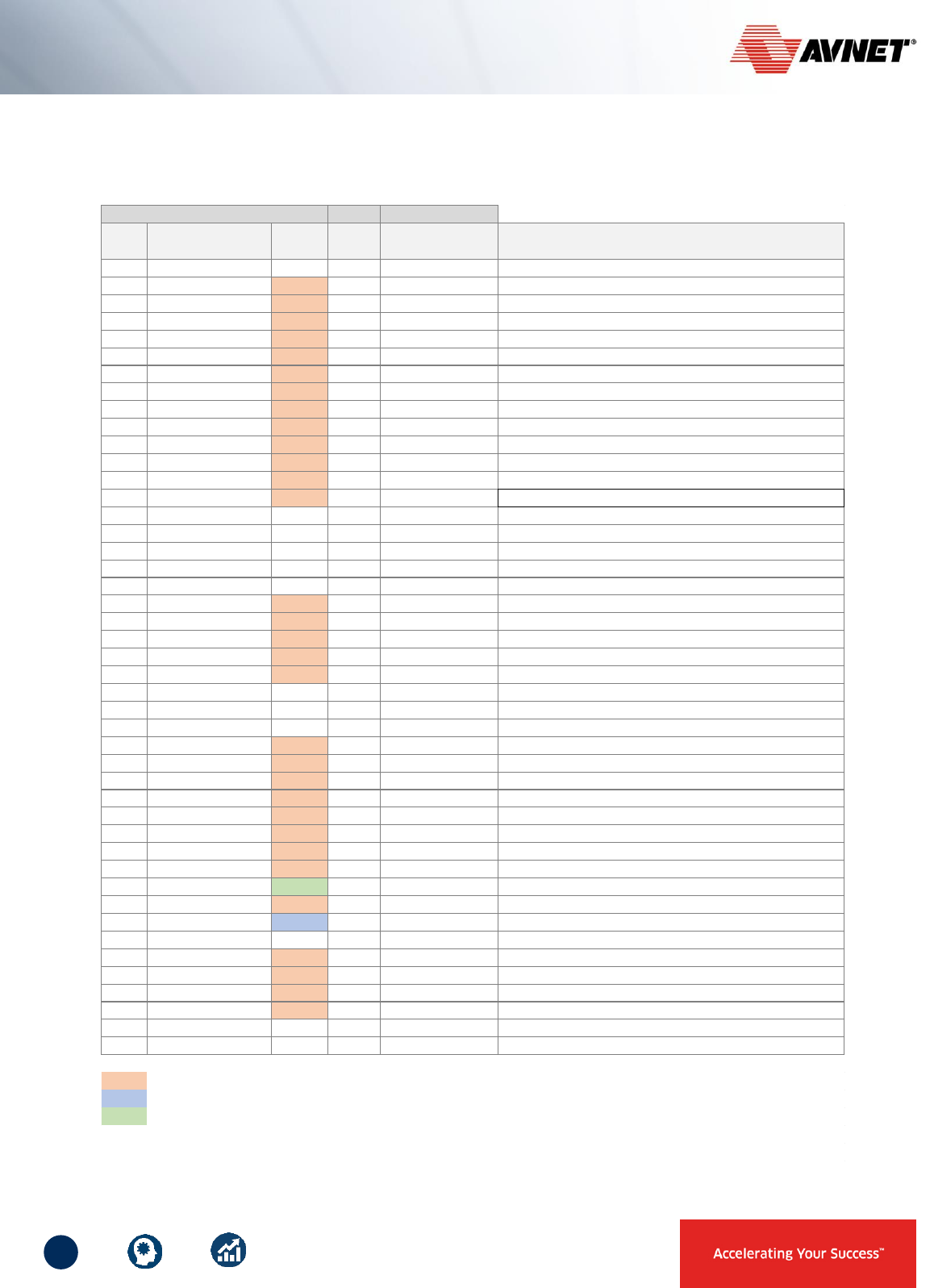
9
9
AES-BCM4343W-M1-G Datasheet
802.11 b/g/n WLAN, Bluetooth & BLE SoC Module
5 Module Pin Descriptions
5.1 Pin Descriptions
MCU WICED SDK
Pin
No.
Signal Name Type
Pin
Name
Pin
Name Description*
1 GND SIG - - Ground
2 MICRO_I2C2_SCL I/O PB10 WICED_GPIO_20 I2C #2 SCL
3 MICRO_I2C2_SDA I/O PB11 WICED_GPIO_21 I2C #2 SDA
4 MICRO_SPI2_SCK I/O PB13 WICED_GPIO_23 SPI #2 SCK
5 MICRO_SPI2_SSN I/O PB12 WICED_GPIO_22 SPI #2 SSN
6 MICRO_SPI2_MISO I/O PB14 WICED_GPIO_24 SPI #2 MISO
7 MICRO_SPI2_MOSI I/O PB15 WICED_GPIO_25 SPI #2 MOSI
8 USART6_TX_I2S2_MCK I/O PC6 WICED_GPIO_13 USART #6 TX
9 USART6_RX_I2S2_CK I/O PC7 WICED_GPIO_14 USART #6 RX
10 MICRO_UART_TX I/O PA9 WICED_GPIO_9 USART #1 TX
11 MICRO_UART_RX I/O PA10 WICED_GPIO_10 USART #1 RX
12 MICRO_UART_CTS I/O PA11 WICED_GPIO_15 USART #1 CTS
13 MICRO_UART_RTS I/O PA12 WICED_GPIO_16 USART #1 RTS
14 WIFI_GPIO_1 I/O PD13 -
WLAN Tx/Rx Activty (Driven by GPIO_1 of BCM4343W device)
15 GND SIG - - Ground
16 VDD_3V3_SIP SIG - - 3.3V
17 GND SIG - - Ground
18 WL_JTAG_TDI N/C - - No Connect (requires hardware modification for connection)
19 WL_JTAG_TDO N/C - - No Connect (requires hardware modification for connection)
20 MICRO_JTAG_TMS I/O PA13 - JTAG TMS
21 MICRO_JTAG_TCK I/O PA14 - JTAG TCK
22 MICRO_JTAG_TDI I/O PA15 - JTAG TDI
23 MICRO_JTAG_TDO I/O PB3 - JTAG TDO
24 MICRO_JTAG_TRSTN I/O PB4 - JTAG RESETN
25 GND SIG - - Ground
26 VBAT_SIP SIG - - Power supply for backup when VDD_3V3_SIP is not present
27 GND SIG - - Ground
28 MICRO_I2C1_SCL I/O PB6 WICED_GPIO_11 I2C #1 SCL
29 MICRO_I2C1_SDA I/O PB7 WICED_GPIO_12 I2C #1 SDA
30 MICRO_GPIO_3 I/O PC1 WICED_GPIO_27 GPIO 3
31 MICRO_GPIO_2 I/O PC0 WICED_GPIO_26 GPIO 2
32 MICRO_GPIO_4 I/O PC2 WICED_GPIO_28 GPIO 4
33 MICRO_GPIO_5 I/O PC3 WICED_GPIO_17 GPIO 5
34 MICRO_GPIO_6 I/O PB9 WICED_GPIO_19 GPIO 6
35 MICRO_GPIO_1 I/O PB8 WICED_GPIO_18 GPIO 1
36 MICRO_RST_N I/O NRST RESET_N
37 MICRO_ADC_IN1 I/O PA1 WICED_GPIO_2 ADC INPUT #1
38 MICRO_WKUP I/O PA0 WICED_GPIO_1 MCU WAKEUP
39 GND SIG - - Ground
40 MICRO_ADC_IN2 I/O PA2 WICED_GPIO_3 ADC INPUT #2
41 MICRO_ADC_IN3 I/O PA3 WICED_GPIO_4 ADC INPUT #3
42 MICRO_GPIO_0 I/O PB0 WICED_GPIO_29 GPIO 0
43 MICRO_ADC_IN15 I/O PC5 WICED_GPIO_30 ADC INPUT #15
44 GND SIG - - Ground
45 GND SIG - - Ground
Module
- Denotes 5V tolerant I/O
- Standard 3.3V I/O
- Bidirection reset pin with embedded weak pullup
* Note the pin descriptions shown are arbitrary for most MCU connected signals

10
10
AES-BCM4343W-M1-G Datasheet
802.11 b/g/n WLAN, Bluetooth & BLE SoC Module
5.2 Pin Definitions
Of the 44 pads located along 3 edges of the module, 8 connect to GND and 2 are power connections
Most of the remaining module pads are internally connected to the STM32F411 MCU. For this reason,
the signal definition of these pins is somewhat arbitrary given that the pin modes can be configured via
software.
The signal names provided in the Pin Description table shown in section 4.1 align with the names
provided in the Cypress WICED SDK platform.h file. Users have the ability to modify these
configurations and definitions as explained in the STM32F411 datasheet.
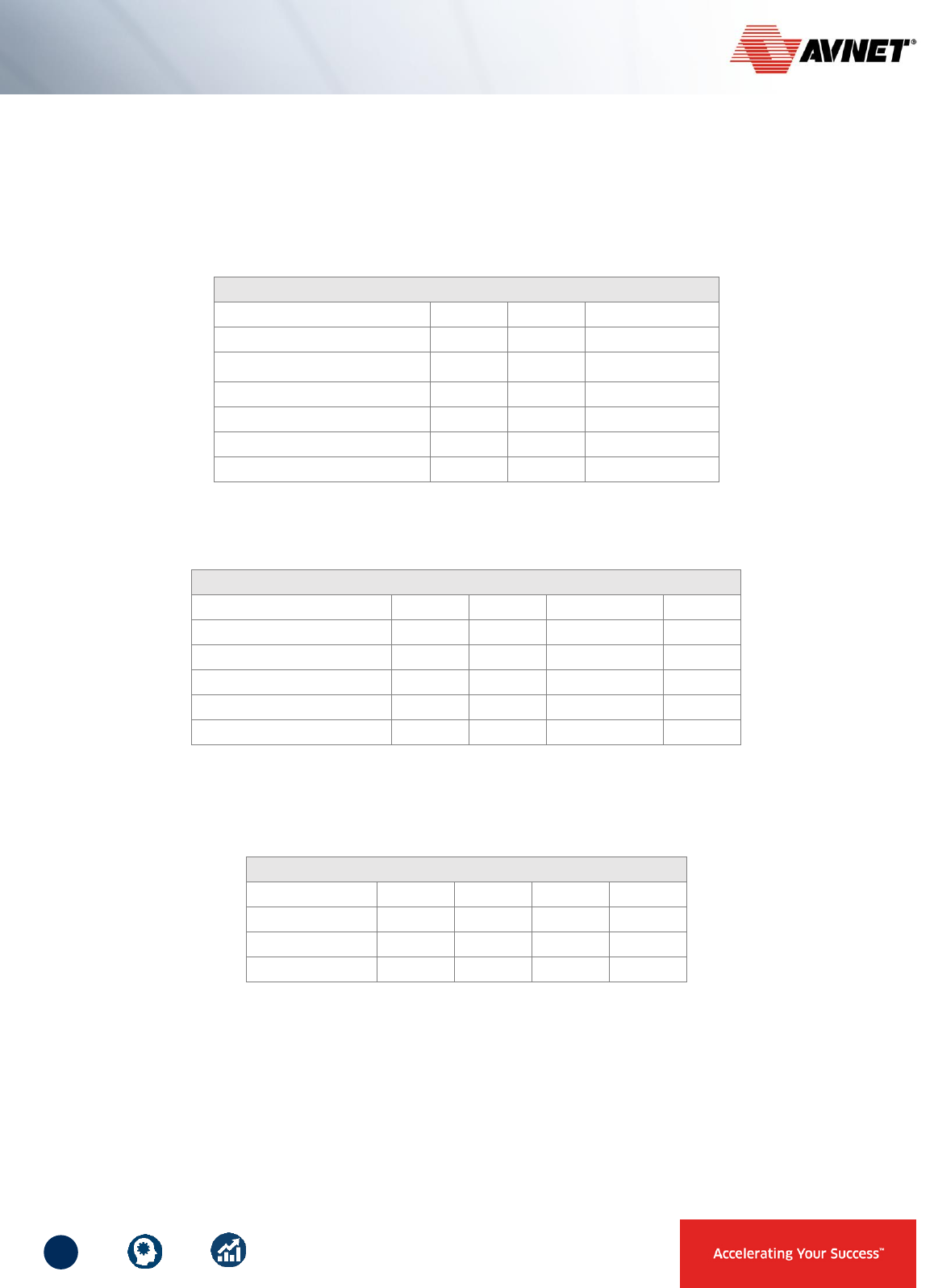
11
11
AES-BCM4343W-M1-G Datasheet
802.11 b/g/n WLAN, Bluetooth & BLE SoC Module
6 Electrical Specifications
For electrical characteristics of the module digital I/O’s connected to the internal STM32F411 MCU,
refer to the STM32F411 datasheet (Document ID 026289 Rev 4 or later).
6.1 Absolute Maximum Ratings
Parameter
Min
Max
Unit
VDD_3V3_SIP
0
4
Volts
VBAT_SIP
0
4
Volts
Voltage on Digital I/Os
-0.3
4
Volts
Voltage on Analog Inputs
-0.3
4
Volts
Supply Ripple
-2
2
%
Storage Temperature
-40
+85
ºC
Operating Temperature
-40
+85
ºC
6.2 Recommended Operating Conditions
Parameter
Min
Typ
Max
Unit
VDD_3V3_SIP
3.0
3.3
3.6
Volts
VBAT_SIP
2.0
3.3
3.6
Volts
Voltage on Digital I/Os
0
3.3
VDD_3V3_SIP
Volts
Voltage on Analog Inputs
0
3.3
VDD_3V3_SIP
Volts
Humidity Range*
0
95
%
Operating Temperature
-40
25
+85
ºC
* Non-condensing, relative humidity
6.3 Power Supply Requirements
Parameter
Min
Typ
Max
Unit
VDD_3V3_SIP
3.0
3.3
3.6
Volts
VDD_3V3_SIP*
-
-
-
mA
VBAT_SIP
2.0
3.3
3.6
Volts
VBAT_SIP*
-
-
-
mA
* See Power Consumption figures on next page
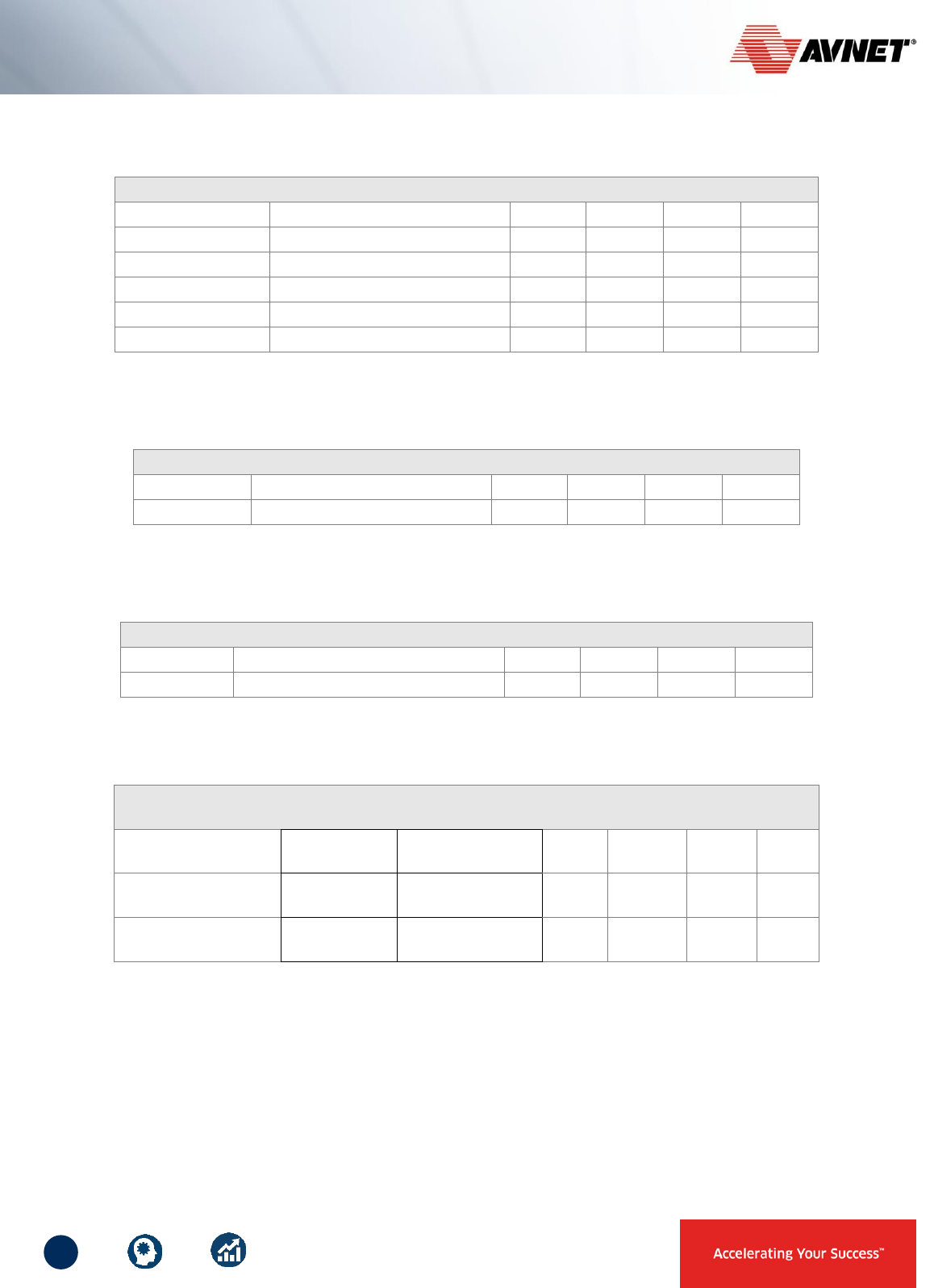
12
12
AES-BCM4343W-M1-G Datasheet
802.11 b/g/n WLAN, Bluetooth & BLE SoC Module
6.4 WLAN Power Consumption
Condition: 25deg.C, includes both Wi-Fi and Microcontroller
Parameter
Test Condition (+25 ºC, 3.3V)
Min
Typ
Max
Unit
11b Tx Mode
11 Mbps
-
400
mA
11g Tx Mode
54 Mbps
-
260
mA
11n Tx Mode
MCS7
-
200
mA
11b Rx Mode
11 Mbps
-
46
mA
11g Rx Mode
54 Mbps
-
46
mA
11n Rx Mode
MCS7
-
46
mA
6.5 Bluetooth Power Consumption
Condition: 25deg.C, includes Both Wi-Fi/BT and Microcontroller
Parameter
Test Condition (+25 ºC, 3.3V)
Min
Typ
Max
Unit
Tx Mode
3DH5
-
35
mA
Rx Mode
3DH5
-
16
mA
6.6 Bluetooth Low Energy Power Consumption
Condition: 25deg.C, includes Both Wi-Fi/BT and Microcontroller
Parameter
Test Condition (+25 ºC, 3.3V)
Min
Typ
Max
Unit
Tx Mode
Transmitter and baseband @ 100%
-
35
mA
Rx Mode
Receiver and baseband @ 100%
-
16
mA
6.7 Low Power Modes Power Consumption
Parameter
Device
Test Condition
(+25 ºC, 3.3V)
Min
Typ
Max
Unit
Sleep Mode
STM32F411
BCM4343W
-
-
-
122
1.48
uA
mA
Power Down Mode
STM32F411
BCM4343W
-
-
-
6.6
6.0
mA
uA
Idle, Unassociated
STM32F411
BCM4343W
-
-
-
8.6
366
mA
uA
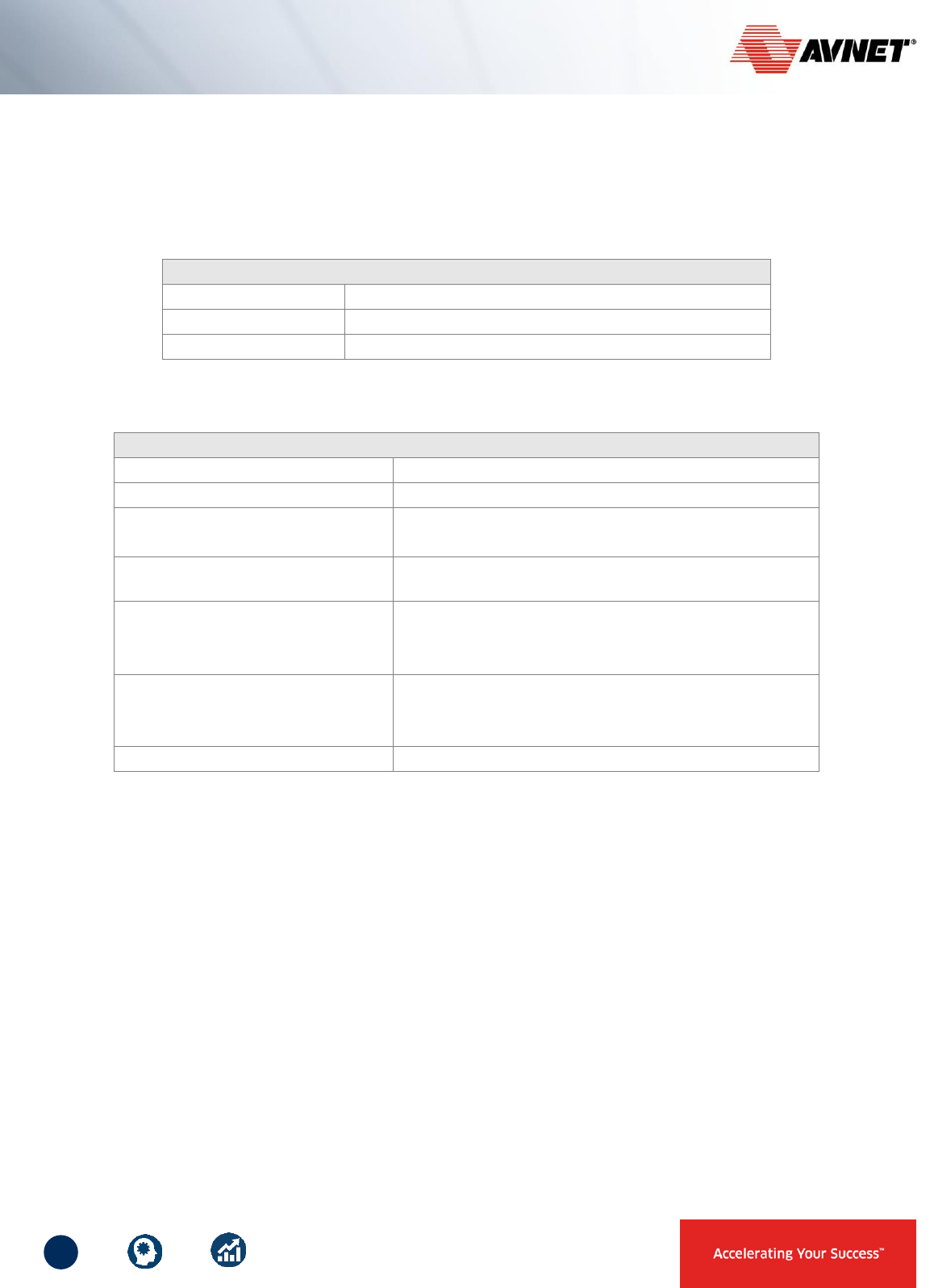
13
13
AES-BCM4343W-M1-G Datasheet
802.11 b/g/n WLAN, Bluetooth & BLE SoC Module
7 RF Specifications
7.1 WLAN RF Characteristics
The AES-BCM4343W-M1-G module complies with the following WLAN features and standards.
Features
Description
WLAN Standards
IEEE 802 Part 11b/g/n (802.11b/g/n single stream n)
Antenna Port
Supports single antenna for Wi-Fi
Frequency Band
2.400 - 2.484 GHz
The RF performance of the AES-BCM4343W-M1-G module is given as follows (@ 3.3V):
Features
Description
Frequency band
2.4000 - 2.497 GHz (2.4 GHz ISM Band)
Number of selectable sub-channels
14 Channels
Modulation
OFDM, DSSS (Direct Sequence Spread Spectrum),
DBPSK, DQPSK, CCK, 16QAM, 64QAM
Supported rates
1, 2, 5.5, 11, 6, 9, 12, 24, 36, 48, 54 Mbps
& HT20 MCS 0~7
Maximum receive input level
-10dBm (with PER < 8% @ 11 Mbps)
-20dBm (with PER < 10% @ 54 Mbps)
-20dBm (with PER < 10% @ MCS7)
Output power
17dBm @ 802.11b
13dBM @ 802.11g
12dBM @ 802.11n
Carrier frequency accuracy
+/- 20 ppm (crystal: 26 MHz +/- 10 ppm @ 25 ºC)

14
14
AES-BCM4343W-M1-G Datasheet
802.11 b/g/n WLAN, Bluetooth & BLE SoC Module
7.1.1 Transmitter Specification
7.1.1.1 802.11b Transmitter Specification
Parameter
Test Condition
Min
Typ
Max
Unit
Transmit Output Power Level
1/2/5.5/11 Mbps
-
17
-
dBm
Transmit Center Freq. Tolerance
-
-20
0
20
ppm
Transmit Spectrum Mask
Fc-22MHz<F<FC-11MHz &
Fc+11MHz<F<Fc+22MHz
(1/2/5.5/11 Mbps;
Channel 1~13)
-
-
-30*
dBr
F<FC-22MHz & F>Fc+22MHz
(1/2/5.5/11 Mbps;
Channel 1~13)
-
-
-50*
dBr
Transmit Power-On
10% ~ 90%
-
0.3
2*
us
Transmit Power-Down
90% ~ 10%
-
1.5
2*
us
Transmit Modulation Accuracy
1/2/5.5/11 Mbps
-
-17
-10
dB
Note 1 - "*" Indicates IEEE802.11 specification
7.1.1.2 802.11g Transmitter Specification
Parameter
Test Condition
Min
Typ
Max
Unit
Transmit Output Power Level
6/9/12/18/24/36/48/54 Mbps
-
13
-
dBm
Transmit Center Freq. Tolerance
-
-20
0
20
ppm
Transmit Modulation Accuracy
6 Mbps
-
-
-5*
dB
9 Mbps
-
-
-8*
dB
12 Mbps
-
-
-10*
dB
18 Mbps
-
-
-13*
dB
24 Mbps
-
-
-16*
dB
36 Mbps
-
-
-19*
dB
48 Mbps
-
-
-22*
dB
54 Mbps
-
-
-25*
dB
Transmit Spectrum Mask
@ 11 MHz
-
-
-20*
dBr
@ 20 MHz
-
-
-28*
dBr
@ 30 MHz
-
-
-40*
dBr
Note 1 - "*" Indicates IEEE802.11 specification
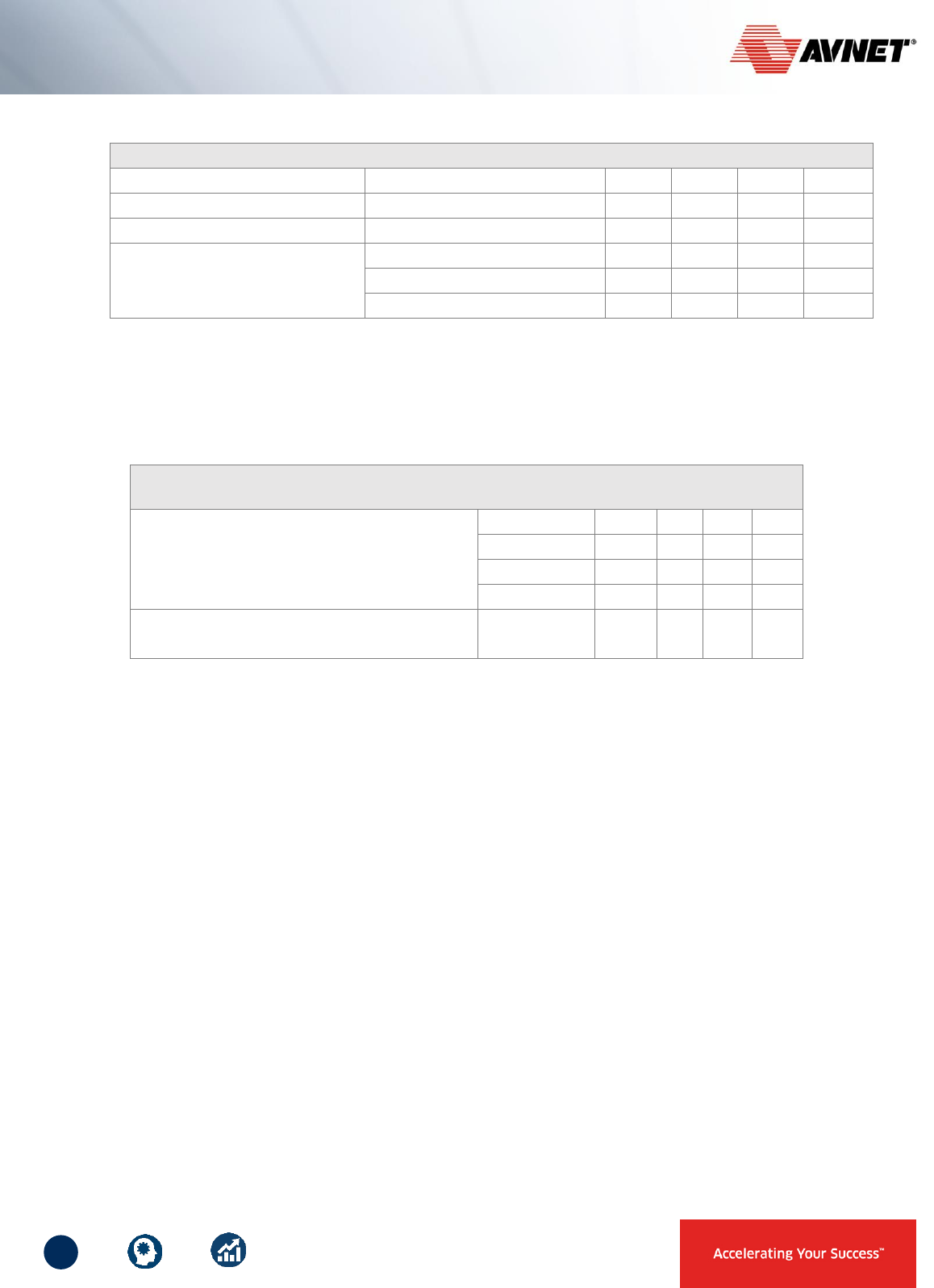
15
15
AES-BCM4343W-M1-G Datasheet
802.11 b/g/n WLAN, Bluetooth & BLE SoC Module
7.1.1.3 802.11n Transmitter Specification
Parameter
Test Condition
Min
Typ
Max
Unit
Transmit Output Power Level
HT20 MCS 0~7
-
12
-
dBm
Transmit Center Freq. Tolerance
-
-20
0
20
ppm
Transmit Modulation Accuracy
HT20, MCS0~7
-
-
-27*
dB
Transmit Spectrum Mask
@ 11 MHz
-
-
-20*
dBr
@ 20 MHz
-
-
-28*
dBr
@ 30 MHz
-
-
-40*
dBr
Note 1 - "*" Indicates IEEE802.11 specification
7.1.2 Receiver Specification
7.1.2.1 802.11b Receiver Specification
Parameter
Test
Condition
Min
Typ
Max
Unit
Receiver Minimum Input Level Sensitivity
(PER < 8%)
1 Mbps
-80*
-93
-
dBm
2 Mbps
-80*
-91
-
dBm
5.5 Mbps
-76*
-89
-
dBm
11 Mbps
-76*
-86
-
dBm
Receiver Maximum Input Level Sensitivity
(PER < 8%)
1/2/5.5/11
Mbps
-10*
-
-
dBm
Note 1 - "*" Indicates IEEE802.11 specification
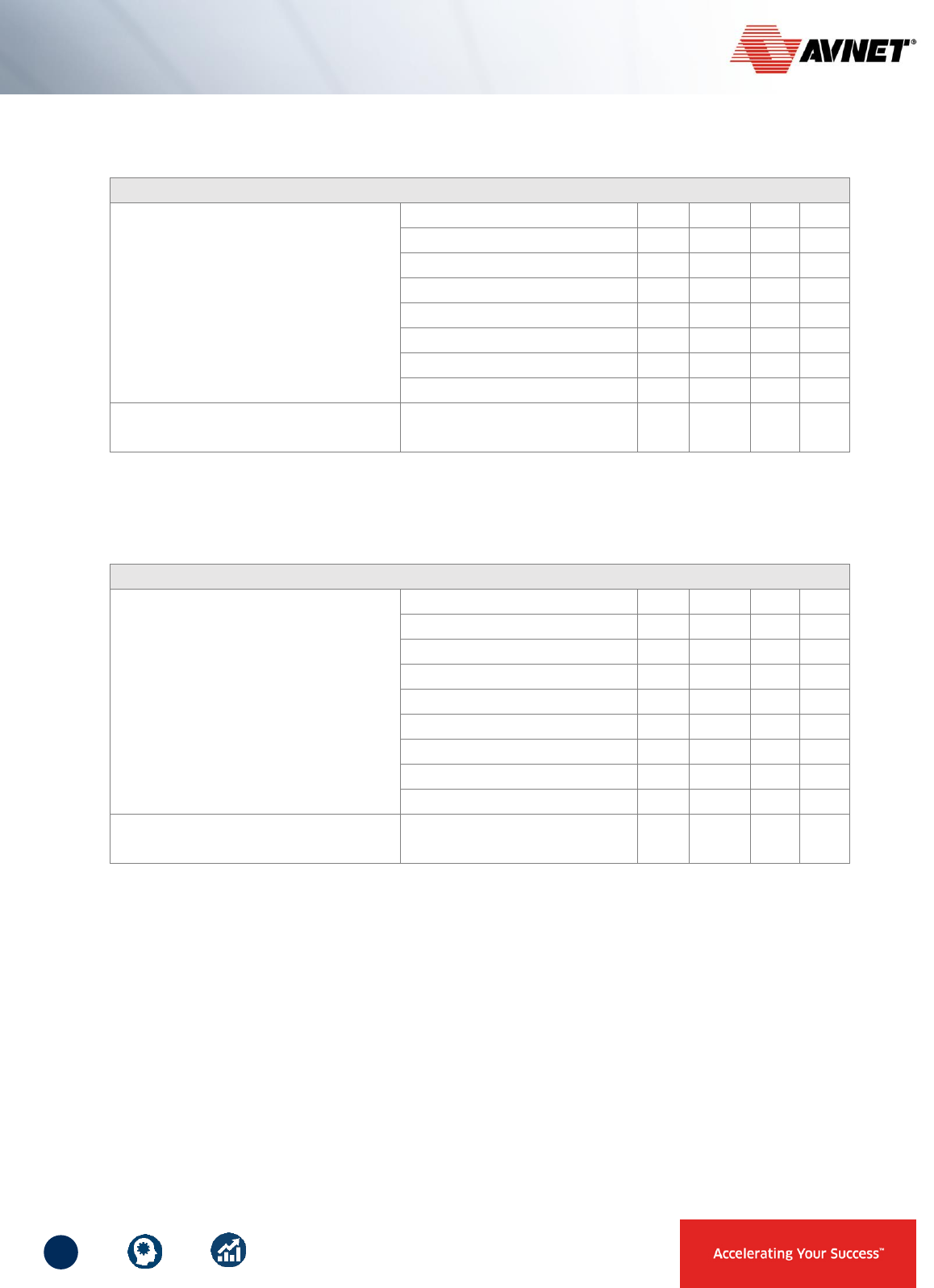
16
16
AES-BCM4343W-M1-G Datasheet
802.11 b/g/n WLAN, Bluetooth & BLE SoC Module
7.1.2.2 802.11g Receiver Specification
Parameter
Test Condition
Min
Typ
Max
Unit
Receiver Min. Input Level Sensitivity
(PER < 10%)
6 Mbps
-82*
-88
-
dBm
9 Mbps
-81*
-87
-
dBm
12 Mbps
-79*
-85
-
dBm
18 Mbps
-77*
-83
-
dBm
24 Mbps
-74*
-80.5
-
dBm
36 Mbps
-70*
-78.5
-
dBm
48 Mbps
-66*
-74
-
dBm
54 Mbps
-65*
-72
-
dBm
Receiver Max. Input Level Sensitivity
(PER < 10%)
6/9/12/18/24/36/48/54 Mbps
-20*
-
-
dBm
Note 1 - "*" Indicates IEEE802.11 specification
7.1.2.3 802.11n Receiver Specification
Parameter
Test Condition
Min
Typ
Max
Unit
Receiver Min. Input Level Sensitivity
(PER < 10%)
HT20, MSC0
-82*
-87.5
-
dBm
HT20, MSC1
-79*
-84
-
dBm
HT20, MSC2
-77*
-82
-
dBm
HT20, MSC3
-74*
-80.5
-
dBm
HT20, MSC4
-70*
-77
-
dBm
HT20, MSC5
-66*
-72
-
dBm
HT20, MSC6
-65*
-71
-
dBm
HT20, MSC7
-64*
-70
-
dBm
MSC0 ~ MSC7
-20*
-
-
dBm
Receiver Max. Input Level Sensitivity
(PER < 10%)
MSC0 ~ MSC7
-20*
-
-
dBm
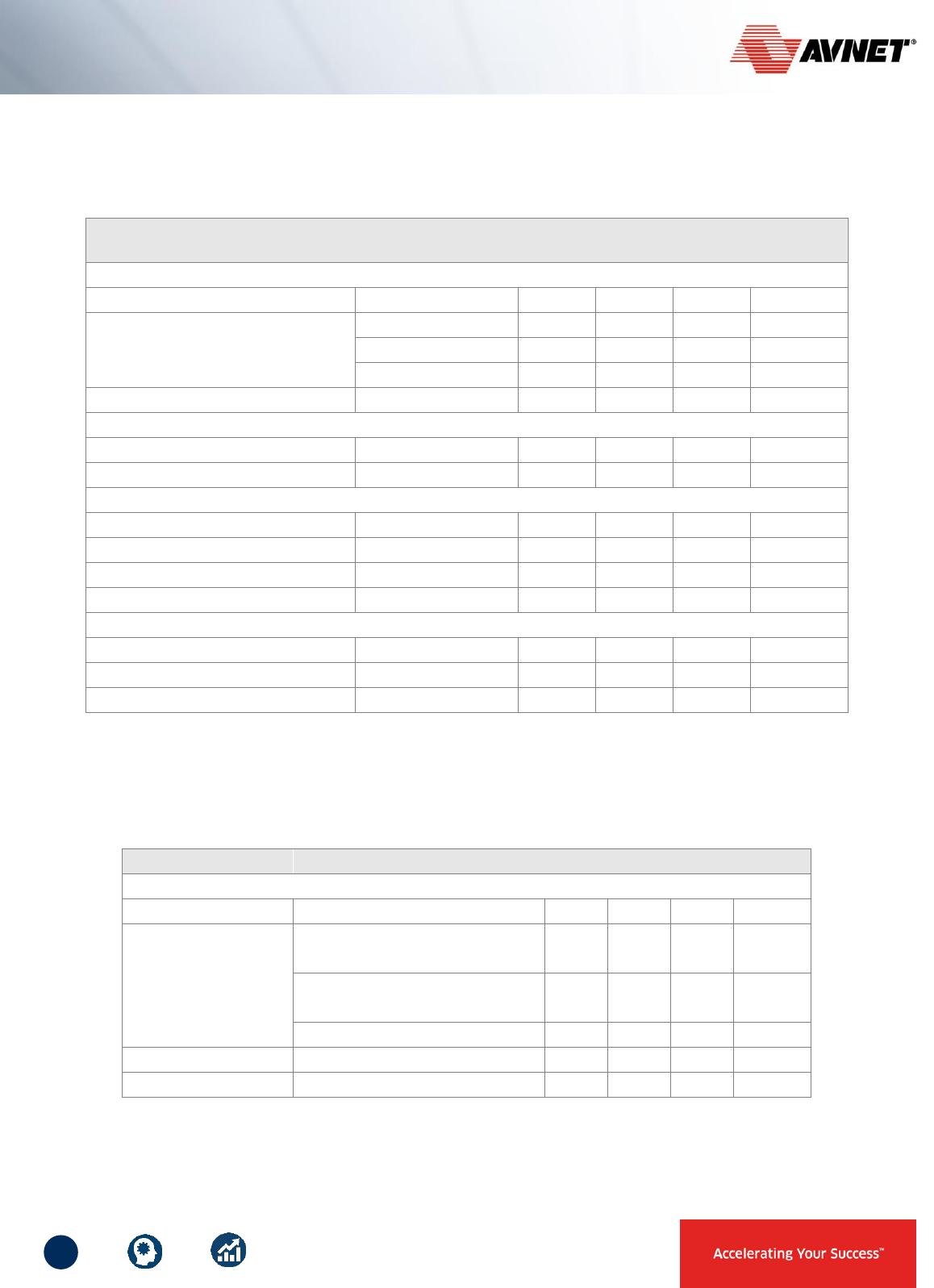
17
17
AES-BCM4343W-M1-G Datasheet
802.11 b/g/n WLAN, Bluetooth & BLE SoC Module
7.2 Bluetooth RF Characteristics
7.2.1 Transmitter Specification
Parameter
Mode and
Condition
Min
Typ
Max
Unit
Transmitter Section
Frequency Range
-
2402.0
-
2480
MHz
Output Power
GFSK
-
10
-
dBm
QPSK
-
6
-
dBm
BPSK
-
6
-
dBm
Power Control Step
2
4
8
dB
Lo Performance
Initial Carrier Freq. Tolerance
-
-
+/-25
+/-75
KHz
Lock Time
-
-
72
-
uS
Frequency Drift
DH1 Packet
-
-
+/-8
+/-25
KHz
DH3 Packet
-
-
+/-8
+/-40
KHz
DH5 Packet
-
-
+/-8
+/-40
KHz
Drift Rate
-
-
5
20
KHz/50 us
Frequency Deviation
00001111 Sequence in Payload (a)
-
140
155
175
KHz
10101010 Sequence in Payload (b)
-
115
140
-
KHz
Channel Spacing
-
-
1
-
MHz
(a) This pattern represents an average deviation in payload
(b) Pattern represents the maximum deviation in payload for 99.9% of all frequency deviations
7.2.2 Receiver Specification
Parameter
Mode and Condition
Min
Typ
Max
Unit
Receiver Section
Frequency Range
-
2402
-
2480
MHz
Output Power
GFSK, 0.1% BER, 1 Mbps
-
-91
-
dBm
/4-DQPSK, 0.01% BER, 2 Mbps
-
-93
-
dBm
8-DPSK, 0.01% BER, 3 Mbps
-
-87
-
dBm
Input IP3
-16
-
-
dBm
Maximum Input
-
-
-
-20
dBm
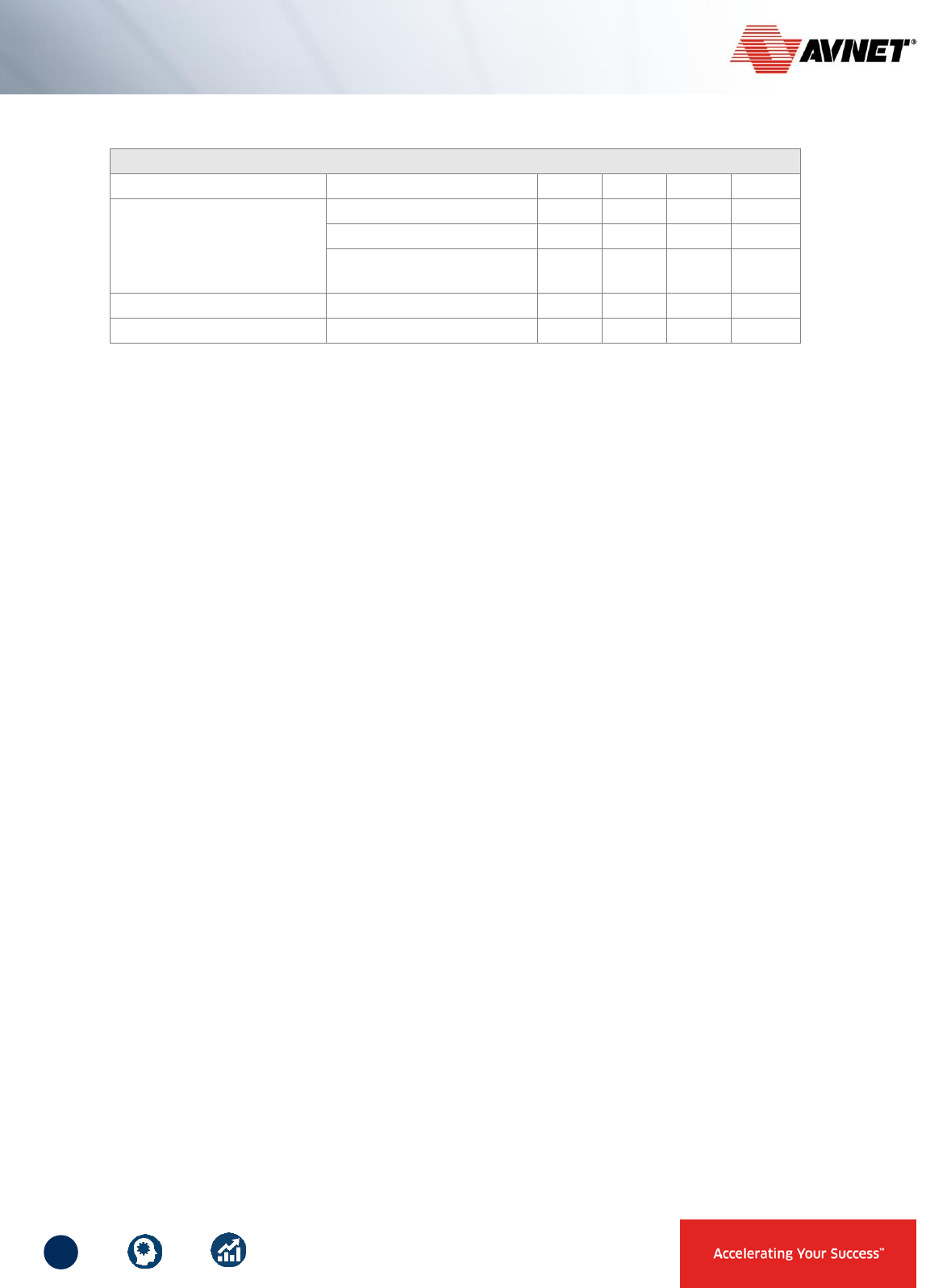
18
18
AES-BCM4343W-M1-G Datasheet
802.11 b/g/n WLAN, Bluetooth & BLE SoC Module
7.3 BLE RF Characteristics
Parameter
Mode and Condition
Min
Typ
Max
Unit
Frequency Range
-
2402
-
2480
MHz
Rx Sense (a)
GFSK, 0.1% BER, 1 Mbps
-
-94
-
dBm
TX Power
-
-
8
-
dBm
Mod Char: Delta f1
Average
-
225
225
275
KHz
Mod Char: Delta f2 max (b)
-
99.9
-
-
%
Mod Char: Ratio
-
0.8
0.95
-
%
Note (a) - The Bluetooth tester is set so that Dirty TX is on
Note (b) - At least 99.9% of all delta F2 max. frequency values recorded over 10 packets
must be greater than 185 KHz
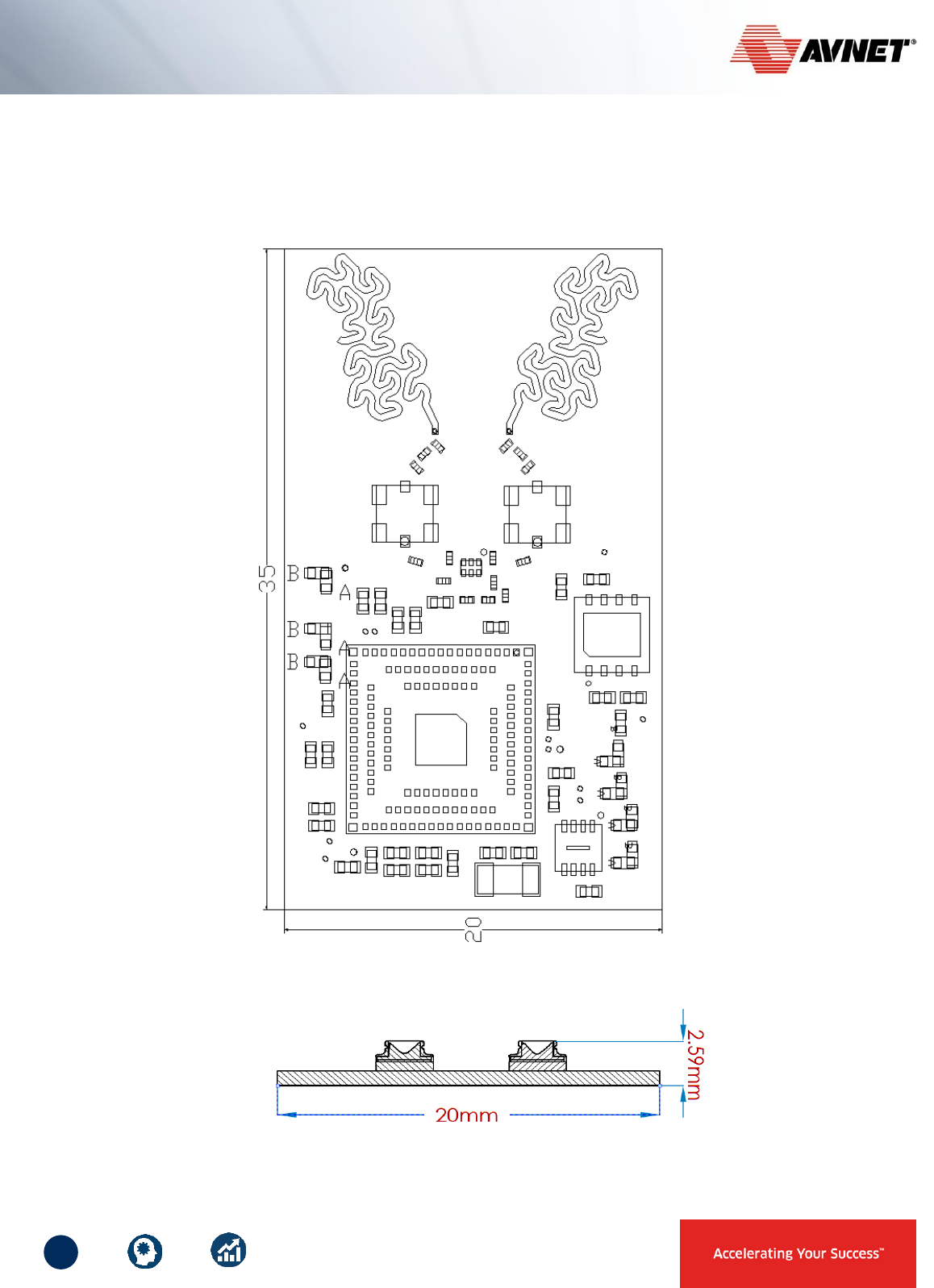
19
19
AES-BCM4343W-M1-G Datasheet
802.11 b/g/n WLAN, Bluetooth & BLE SoC Module
8 Mechanical Specifications
8.1 Mechanical Size
Module dimensions are 35 mm x 20 mm x 2.59 mm (max) as shown in the figures below.
Figure 2 – AES-BCM4343W-M1-G Module Top View
Figure 3 – AES-BCM4343W-M1-G Module Side View
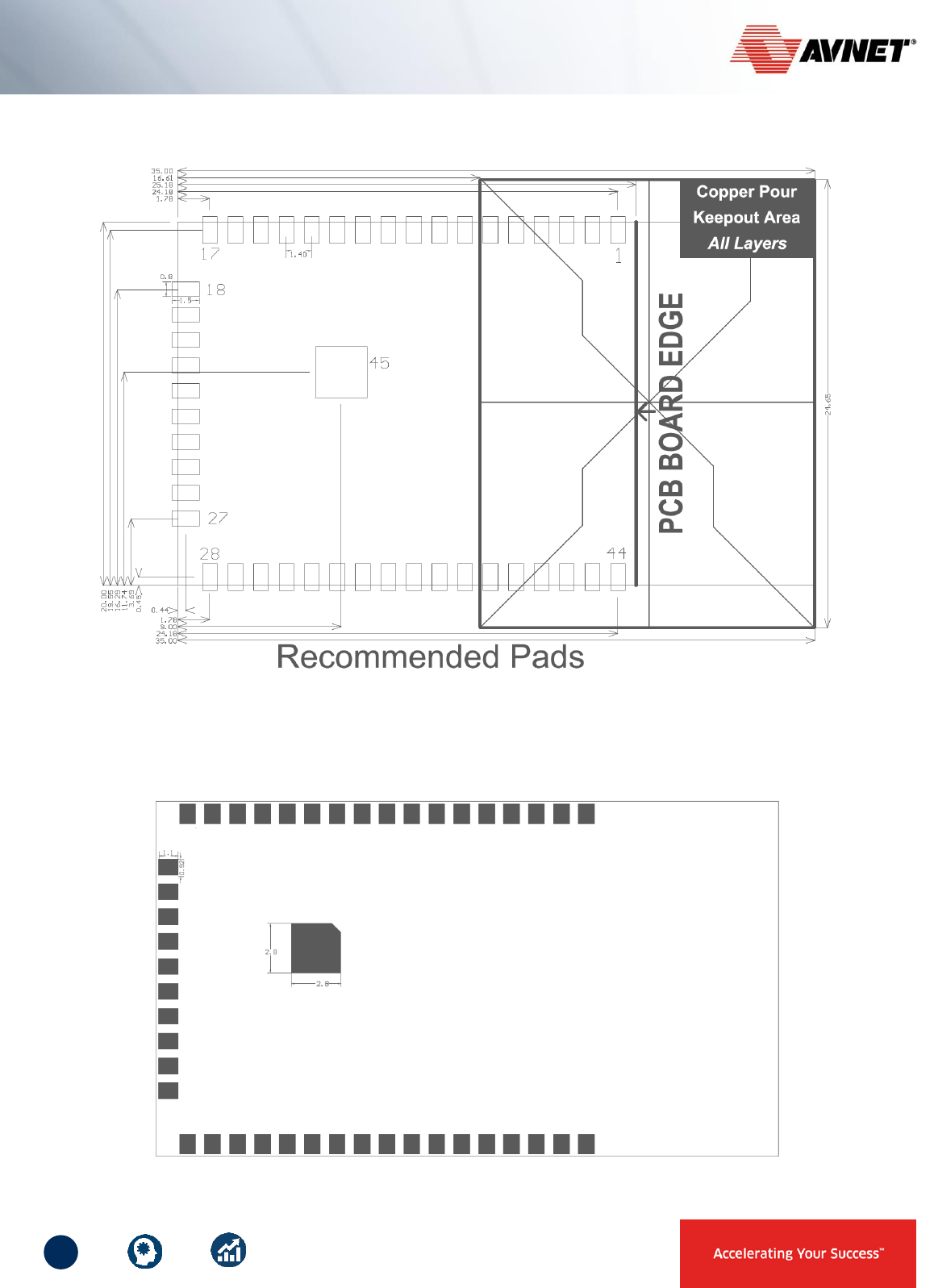
20
20
AES-BCM4343W-M1-G Datasheet
802.11 b/g/n WLAN, Bluetooth & BLE SoC Module
8.2 Module PCB Footprint
Figure 4 – AES-BCM4343W-M1-G Module PCB Footprint
8.3 Module Pad Size
Figure 5 – AES-BCM4343W-M1-G Module Pad Size
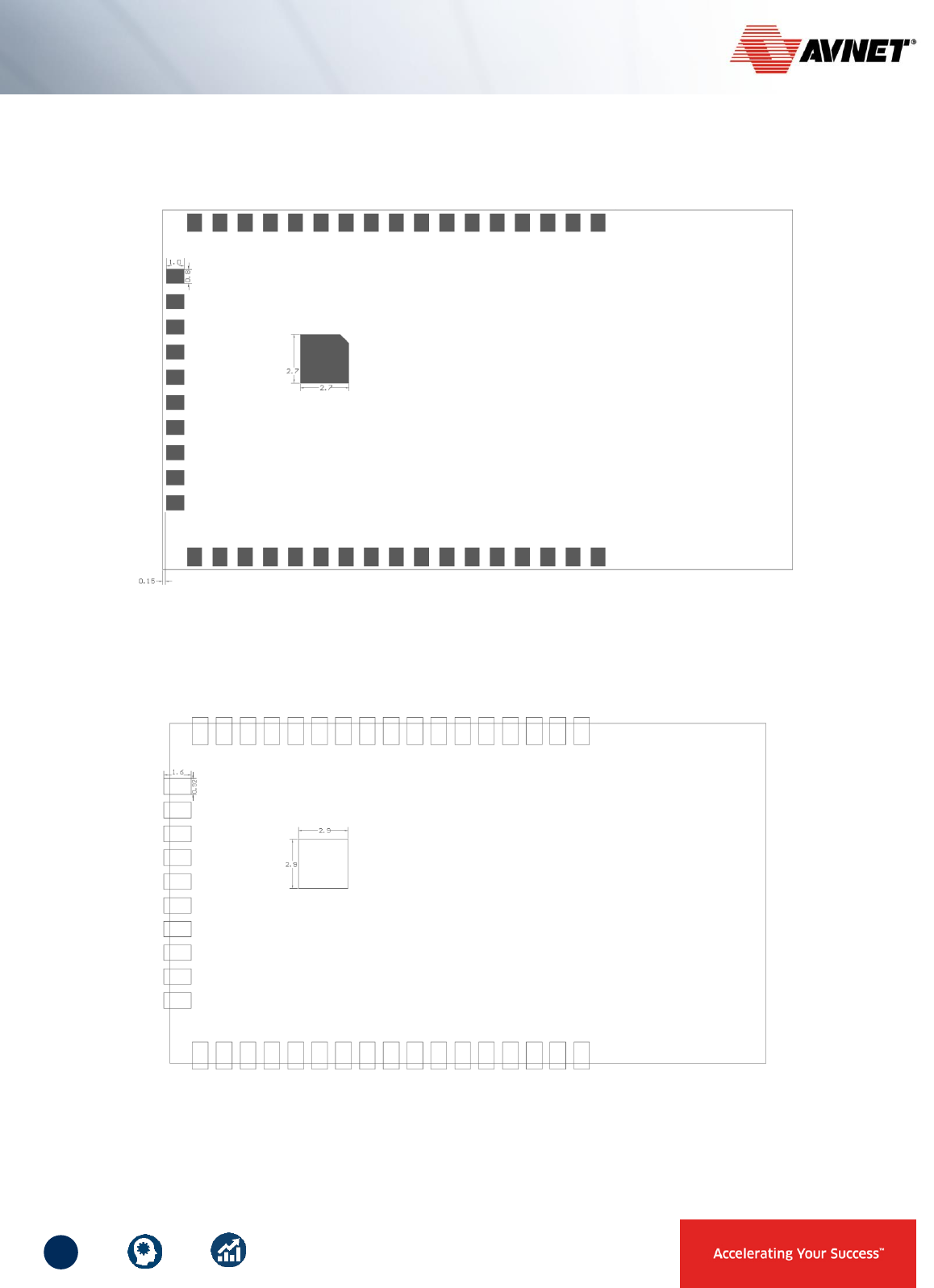
21
21
AES-BCM4343W-M1-G Datasheet
802.11 b/g/n WLAN, Bluetooth & BLE SoC Module
8.4 Recommended Solder Paste Mask
Figure 6 – Recommended Solder Paste Mask Size
8.5 Recommended Solder Mask
Figure 7 – Recommended Solder Mask Size
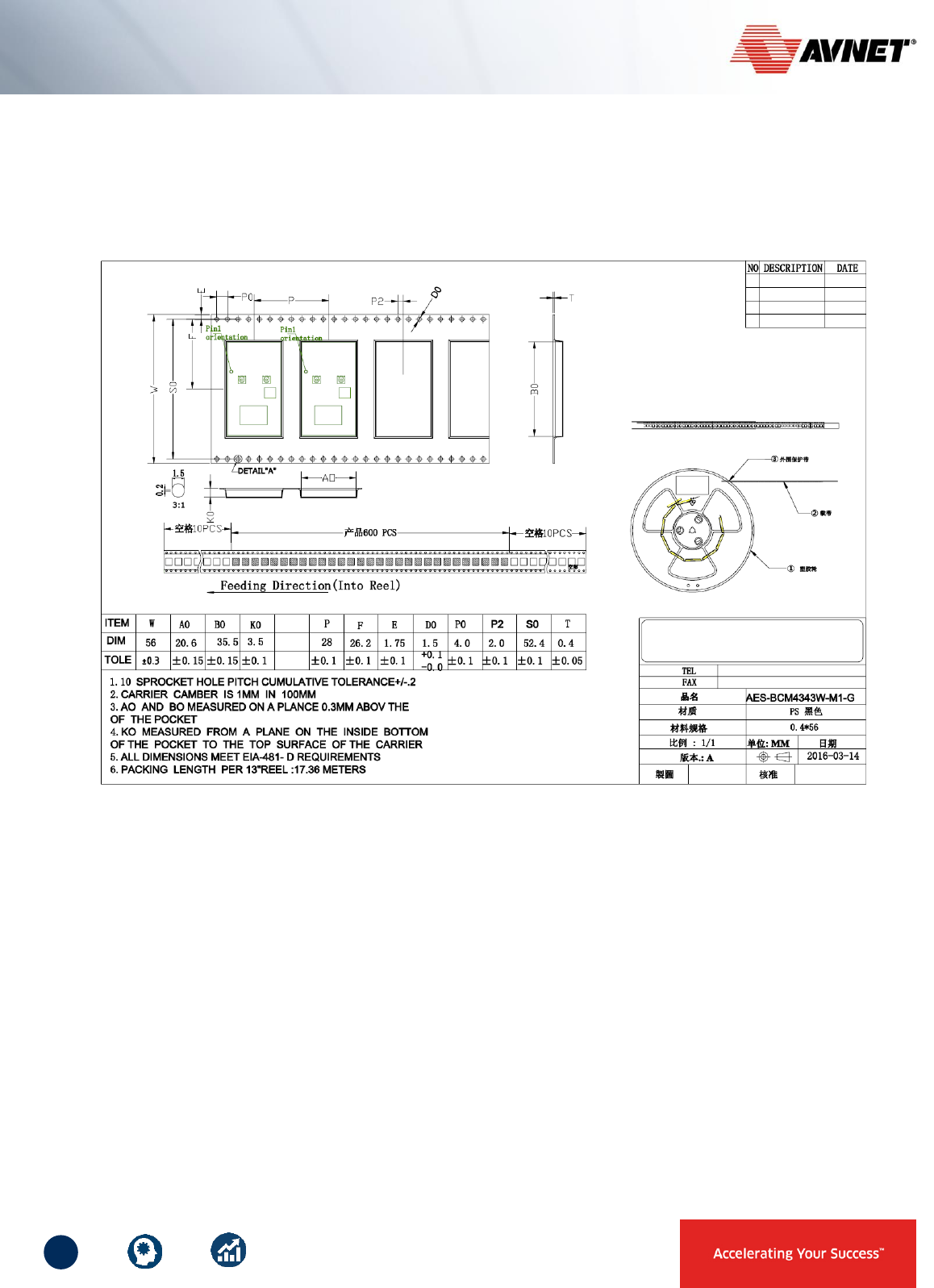
22
22
AES-BCM4343W-M1-G Datasheet
802.11 b/g/n WLAN, Bluetooth & BLE SoC Module
8.6 Tape and Reel Packaging
The AES-BCM4343W-M1-G module is available in tape and reel packaging at quantities of 600 units.
The reel dimensions are 13 inches x 56 mm.
The 56 mm tape conforms to the Electronic Components Association Standard EIA-481-D.
Figure 8 – Tape Dimensions
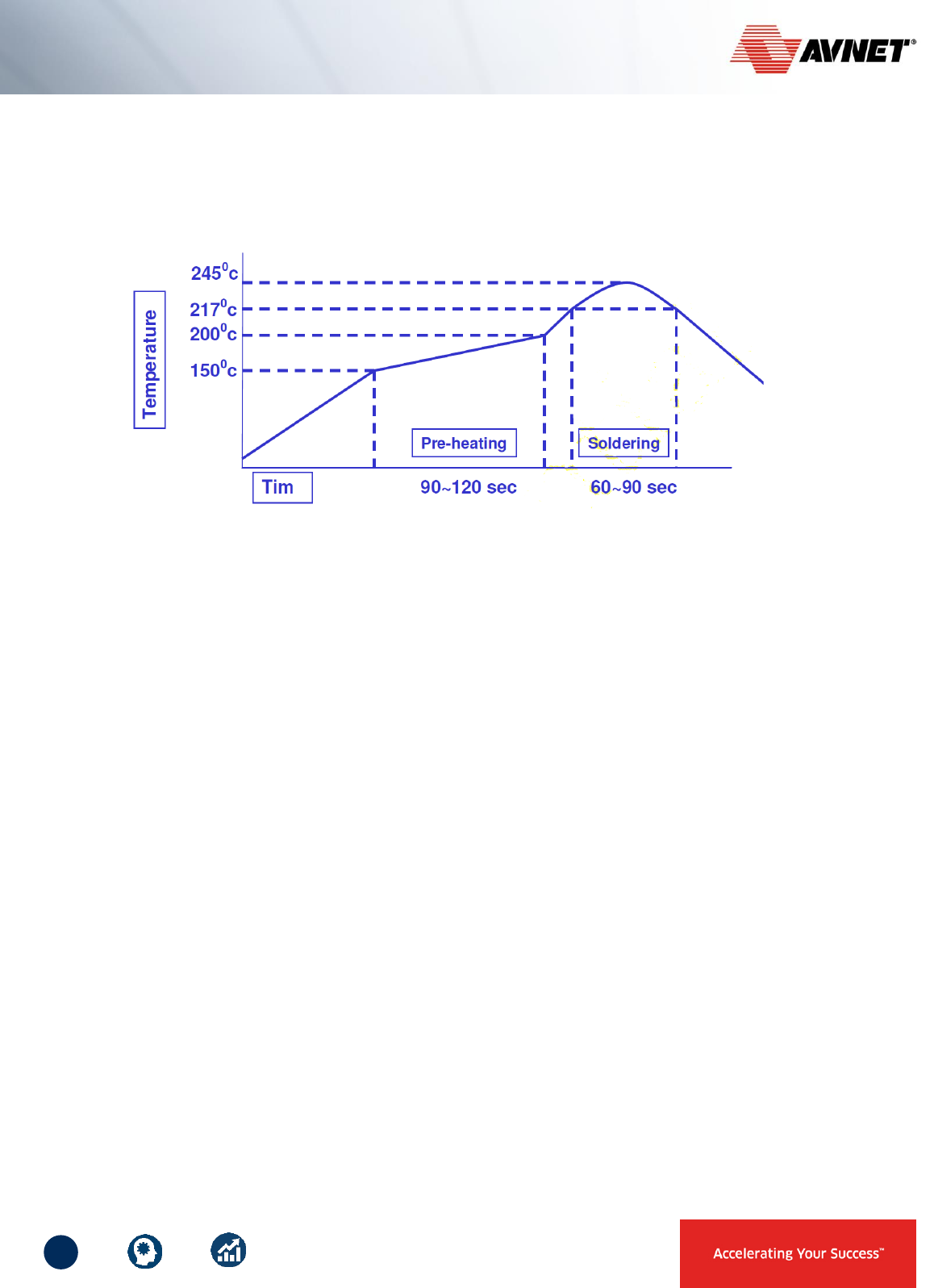
23
23
AES-BCM4343W-M1-G Datasheet
802.11 b/g/n WLAN, Bluetooth & BLE SoC Module
9 Soldering and Cleaning Recommendations
9.1 Optimum Soldering Reflow Profile
Figure 9 – Recommended Soldering Profile for Lead-Free Solder
Solder joint quality between the module’s LGA surface mount pads and their bonding with the host
board should meet the appropriate IPC Specification.
(See IPC-A-610-D Acceptability of Electronic Assemblies, section 8.2.1 “Bottom Only Terminations”)
It is recommended that only a single reflow soldering process be permitted for the host board
Any attempts at reworking the module will invalidate warrantee coverage and regulatory certifications
9.2 Cleaning
Cleaning of the populated module is not recommended! Residuals under the module cannot be easily
removed by any cleaning process (Water / Solvents / Ultrasonic)

24
24
AES-BCM4343W-M1-G Datasheet
802.11 b/g/n WLAN, Bluetooth & BLE SoC Module
10 Antennas
Two onboard Fractal PCB antennas provide antenna diversity and good RF performance.
(The Cypress patented PCB antenna trace pattern achieves a gain of 3dBi)
Figure 10 – Dual Fractal PCB Antennas
Two surface mount miniature RF (3mm x 3mm) switched coax connectors are included onboard.
These connectors are for TEST PURPOSES ONLY and shall not be used for external antennas!
Figure 11 – Test Probe Connectors (Murata SWD series)
Note! Use of external antennas is not approved in the regulatory certifications for this module!
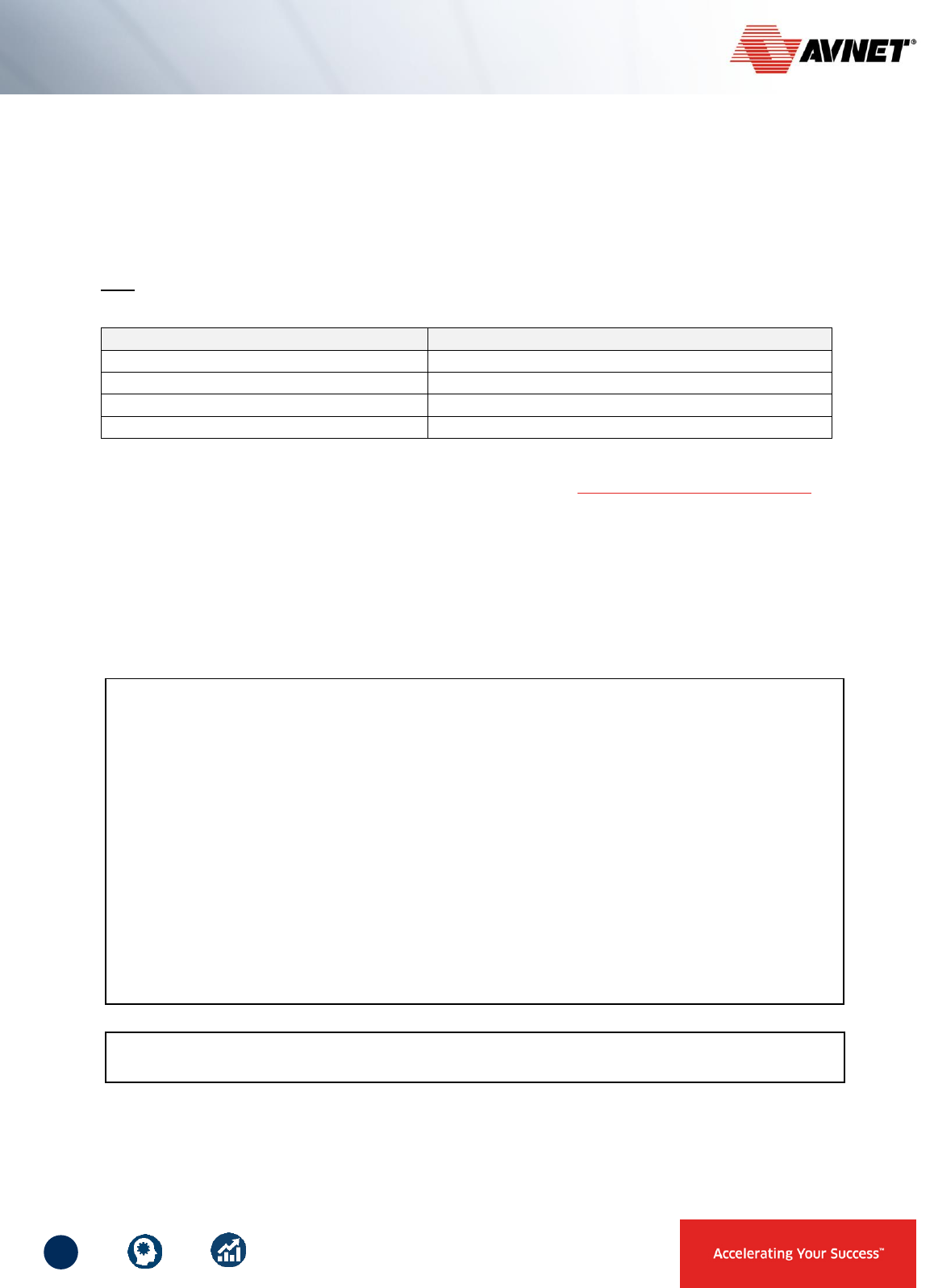
25
25
AES-BCM4343W-M1-G Datasheet
802.11 b/g/n WLAN, Bluetooth & BLE SoC Module
11 Certifications
11.1 RoHS
The AES-BCM4343W-M1-G module is lead-free and RoHS compliant.
11.2 Regulatory Compliance
Note: FCC, IC and CE certifications are currently pending (Once the certification process has been
concluded, this datasheet will be updated to remove this note)
Regulatory Body
Status
FCC
2AF62-AVTEG001 (Pending)
IC
21571-AVTEG001 (Pending)
RoHS
Compliant
CE
EN 60950-1, EN 300 328, EN 301 489 (Pending)
Should regulatory certification be required in a specific country or region not already covered, please
contact your local Avnet sales office or create a support request at http://cloudconnectkits.org/forum
11.3 Bluetooth Interoperability Compliance
BQB application in progress
11.4 Regulatory Agency Statements
The User Manual for the End Product should include the following statements:
FCC Interference Statement
This equipment has been tested and found to comply with the limits for a Class B digital device,
pursuant to Part 15 of the FCC Rules. These limits are designed to provide reasonable protection
against harmful interference in a residential installation. This equipment generates uses and can
radiate radio frequency energy and, if not installed and used in accordance with the instructions, may
cause harmful interference to radio communications. However, there is no guarantee that interference
will not occur in a particular installation. If this equipment does cause harmful interference to radio or
television reception, which can be determined by turning the equipment off and on, the user is
encouraged to try to correct the interference by one of the following measures:
▪ Reorient or relocate the receiving antenna.
▪ Increase the separation between the equipment and receiver.
▪ Connect the equipment into an outlet on a circuit different from that to which the receiver is
connected.
▪ Consult the dealer or an experienced radio/TV technician for help.
FCC Caution: Any changes or modifications not expressly approved by the party responsible for
compliance could void the user's authority to operate this equipment.

26
26
AES-BCM4343W-M1-G Datasheet
802.11 b/g/n WLAN, Bluetooth & BLE SoC Module
User manuals shall display the following Industry Canada notices in a conspicuous location:
11.5 OEM Instructions
This module has been certified for installation into products only by OEM integrators under the following
conditions:
The antennas used with this module must be installed to provide a separation distance of at least 20cm
from all persons, and must not be co-located or transmit simultaneously with any other antenna or
transmitter, except in accordance with FCC multi transmitter product procedures.
11.6 OEM Labeling Requirements
A clearly visible label is required, affixed to the outside of the user’s (OEM) enclosure.
This label should display the following:
11.7 Limitations
This product is not intended for use in safety-critical applications (such as life support) where a failure
of the Avnet product could be expected to cause severe personal injury or death.
Contains FCC ID: 2AF62-AVTEG001
Contains IC: 21571-AVTEG001
This device complies with Part 15 of the FCC Rules.
Operation is subject to the following two conditions:
(1) This device may not cause harmful interference, and
(2) This device must accept any interference received,
including interference that may cause undesired operation.
Industry Canada Statements
This Device complies with Industry Canada License-exempt RSS standard(s). Operation is subject to
the following two conditions: (1) this device may not cause interference, and (2) this device must accept
any interference, including interference that may cause undesired operation of the device.
Le présent appareil est conforme aux CNR d'Industrie Canada applicables aux appareils radio exempts
de licence. L'exploitation est autorisée aux deux onditions suivantes: (1) l'appareil ne doit pas produire
de brouillage, et (2) l'utilisateur de l'appa-reil doit accepter tout brouillage radioélectrique subi, meme si
le brouillage est susceptible d'en com-promettre le fonctionnement.
Under Industry Canada regulations, this radio transmitter may only operate using an antenna of a type
and maximum (or lesser) gain approved for the transmitter by Industry Canada. To reduce potential
radio interference to other users, the antenna type and its gain should be so chosen that the
equivalent isotropically radiated power (EIRP) is not more than that necessary for successful
communication.
Conformément à la réglementation d'Industrie Can-ada, le présent émetteur radio peut fonctionner avec
une antenne d'un type et d'un gain maximal (ou infé-rieur) approuvé pour l'émetteur par Industrie Can-
ada. Dans le but de réduire les risques de brouil-lage radioélectrique à l'intention des autres utilisa-
teurs, il faut choisir le type d'antenne et son gain de sorte que la puissance isotrope rayonnée
équivalente (p.i.r.e.) ne dépasse pas l'intensité nécessaire à l'établissement d'une communication
satisfaisante.

27
27
AES-BCM4343W-M1-G Datasheet
802.11 b/g/n WLAN, Bluetooth & BLE SoC Module
12 Shipping, Handling and Storage
12.1 Shipping
Bulk orders of the Avnet BCM4343W SoC module are delivered in reels of 600.
(See Section 7.6 for detail)
12.2 Handling
The AES-BCM4343W-M1-G module contains sensitive electronic circuitry that require proper ESD
protection when handling. Failure to follow these ESD procedures may result in permanent damage to
the module.
The module should not be subjected to excessive mechanical shock.
12.3 Moisture Sensitivity (MSL)
Modules that have been exposed to moisture and environmental conditions exceeding the prescribed
packaging and storage conditions detailed in J-STD-020 (eg. not continuously in a sealed bag with a
desiccant pack) MUST be baked before mounting! (Failure to meet the packaging and storage
conditions described, will result in irreparable damage to modules during solder reflow soldering).
For devices that are packaged in a Moisture Barrier Bag with a desiccant pack and HIC (Humidity
Indicator Card), the HIC card should be referenced and J-STD-033 consulted to determine if baking is
required prior to reflow soldering.
In cases where baking is required, refer to J-STD-033 for details of the bake procedure.
“Broken reel” module quantities (under 600 units) typically require baking before reflow soldering
12.4 Storage
Per J-STD-033, the shelf life of devices in a Moisture Barrier Bag is 12 months at <40ºC and <90%
room humidity (RH).
Do not store in salty air or an environment where there is a high concentration of corrosive gas, such
as Cl2, H2S, NH3, SO2, or NOX.
Do not store in direct sunlight.
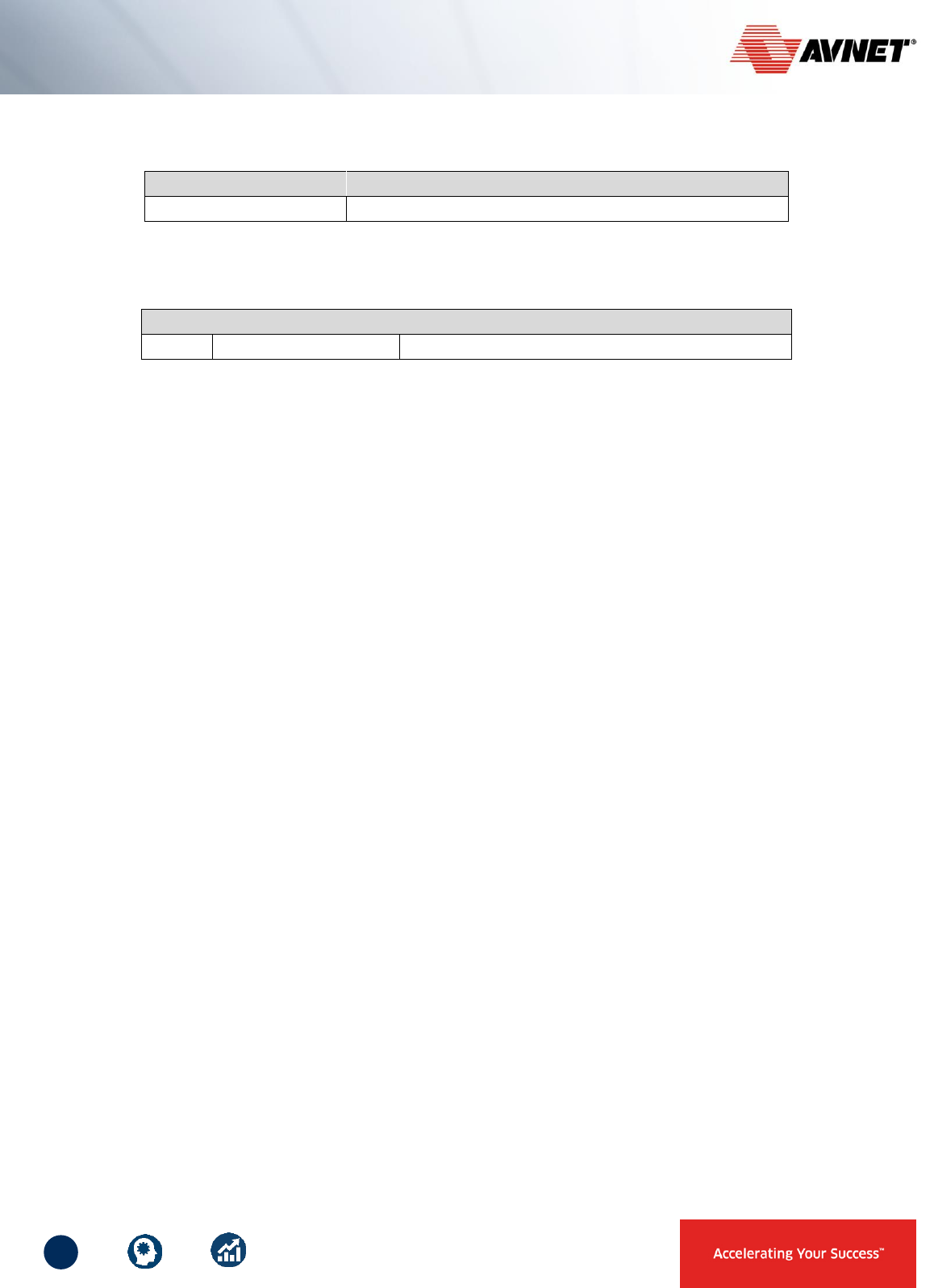
28
28
AES-BCM4343W-M1-G Datasheet
802.11 b/g/n WLAN, Bluetooth & BLE SoC Module
13 Ordering Information
Part Number
Description
AES-BCM4343W-M1-G
802.11 b/g/n WLAN, Bluetooth & BLE SoC Module
13.1 Module Accessories
Manuf.
Part Number
Description
Avnet
AES-EVB-BCM4343W-G
BCM4343W IoT Starter Kit
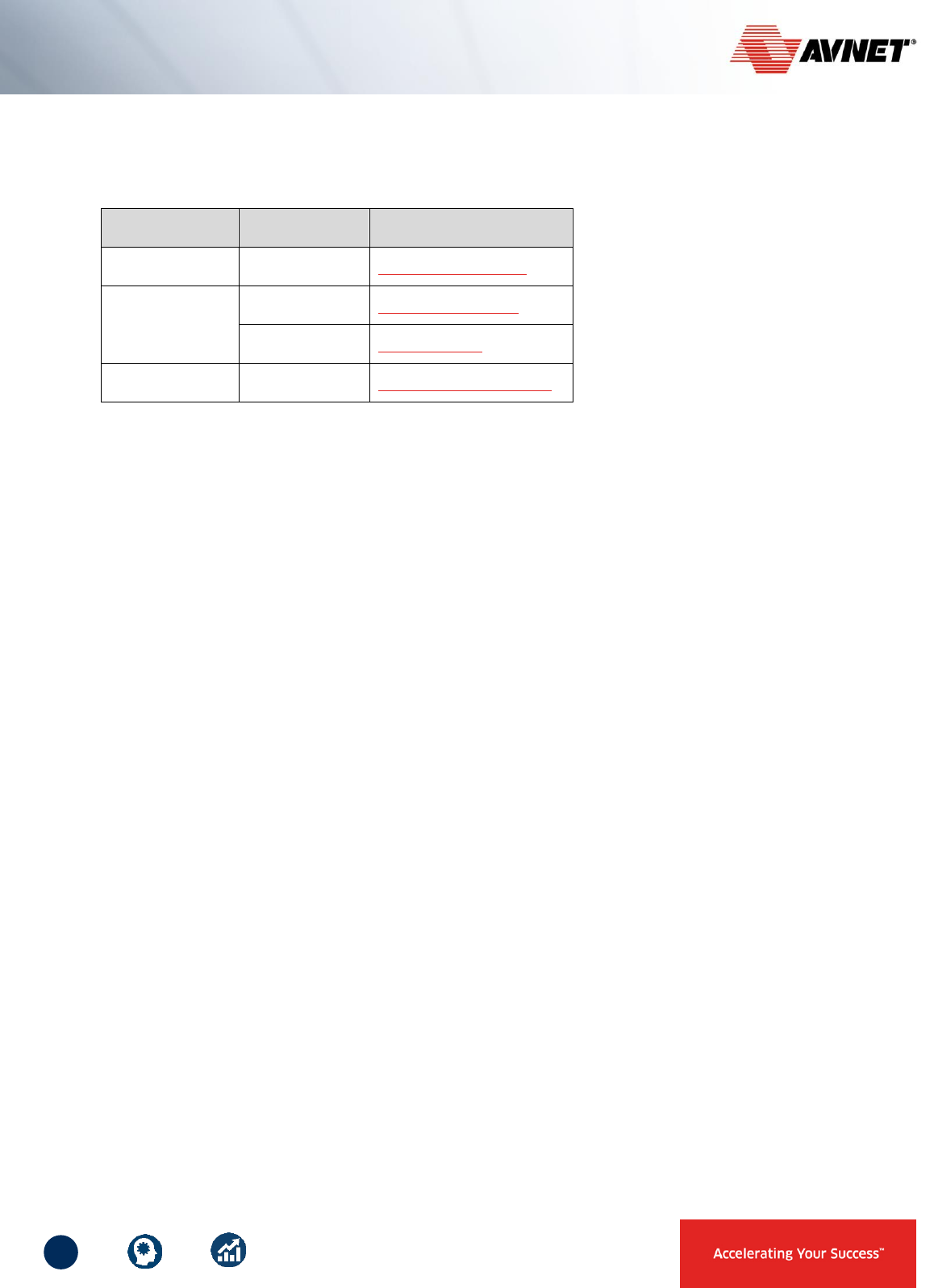
29
29
AES-BCM4343W-M1-G Datasheet
802.11 b/g/n WLAN, Bluetooth & BLE SoC Module
14 Contact Information
For further details, contact your local Avnet representative or e-mail us at:
Region
Organization
Email
North America
Avnet EMA
eval.kits@avnet.com
Europe
Avnet EBV
ebvchips@ebv.com
Avnet Silica
info@avnet.eu
Asia
Avnet Asia
XilinxAPAC@avnet.com

FCC/IC Statements
Integrator is reminded to assure that these installation instructions
will not be made available to the end-user of the final host device.
The final host device, into which this RF Module isintegrated" hasto be labelled
with an auxilliary lable stating the FCC IDofthe RF Module,such as
"This device complies with part 15 of the FCC rules. Operation is subject to the following two
conditions:
(1)this devicemay not cause harmful interference, and
(2)this devicemust accept any interference received, including
interference thatmay cause undesired operation."
approved by the party responsible for compliance could
2AF62-AVTEG001
"Contains FCC ID: "
the Integrator will be responsible to satisfy SAR/ RF Exposure requirements,
when the module integrated into the host device.
The final host device, into which this RF Module isintegrated" hasto be labelled
with an auxilliary lable stating the IC ofthe RF Module,such as
"Contains transmitter module IC:21571-AVTEG001"
void the user’s authority to operate the equipment."
"Changes or modifications to this unit not expressly
This device complies with Industry Canada licence-exempt RSS standard(s). Operation is
subject to the following two conditions:
(1) this device may not cause interference, and
(2) this device must accept any interference, including interference that may cause
undesired operation of the device.
Le présent appareil est conforme aux CNR d'Industrie Canada applicables aux appareils
radio exempts de licence. L'exploitation est autorisée aux deux conditions suivantes :
(1) l'appareil ne doit pas produire de brouillage, et
(2) l'utilisateur de l'appareil doit accepter tout brouillage radioélectrique subi, même si le
brouillage est susceptible d'en compromettre le fonctionnement.
(OEM) Integrator has to assure compliance of the entire end-product incl. the integrated RF Module.
For 15 B (§15.107 and if applicable §15.109) compliance, the host manufacturer is required to
show compliance with 15 while the module is installed and operating.
Furthermore the module should be transmitting and the evaluation should confirm that the module's
intentional emissions (15C) are compliant (fundamental / out-of-band). Finally the integrator has
to apply the appropriate equipment authorization (e.g. Verification) for the new host device per
definition in §15.101.
AES-BCM4343W-M1-G Datasheet
802.11 b/g/n WLAN, Bluetooth & BLE SoC Module
Host 15B and 15C compliance statement
A host product itself is required to comply with all other applicable FCC equipment
authorization regulations, requirements, and equipment functions that are not
associated with the transmitter module portion. For example, compliance must be
demonstrated: to regulations for other transmitter components within a host product;
to requirements for unintentional radiators (Part 15 Subpart B), such as digital
devices, computer peripherals, radio receivers, etc.; and to additional authorization
requirements for the non-transmitter functions on the transmitter module (i.e.,
Verification or Declaration of Conformity) as appropriate (e.g., Bluetooth and Wi-Fi
transmitter modules may also contain digital logic functions).
The OEM integrator or the host manufacturer is responsible for the overall
compliance of the host products
RF exposure statement
Human exposure to RF emissions from mobile devices (47 CFR §2.1091) may be
evaluated based on the MPE limits adopted by the FCC for electric and magnetic field
strength and/or power density, as appropriate, since exposures are assumed to
occur at distances of 20 cm or more from persons.
Module statement
The single-modular transmitter is a self-contained, physically delineated, component
for which compliance can be demonstrated independent of the host operating
conditions, and which complies with all eight requirements of § 15.212(a)(1) as
summarized below.
1) The radio elements have the radio frequency circuitry shielded.
2) The module has buffered modulation/data inputs to ensure that the device will
comply with Part 15 requirements with any type of input signal.
3) The module contains power supply regulation on the module.
4) The module contains a permanently attached antenna.
5) The module demonstrates compliance in a stand-alone configuration.
6) The module is labeled with its permanently affixed FCC ID label
7) The module complies with all specific rules applicable to the transmitter, including
all the conditions provided in the integration instructions by the grantee.
8) The module complies with RF exposure requirements.